Global Film Locations
The grand tour: eurocrash filming locations.
Published by
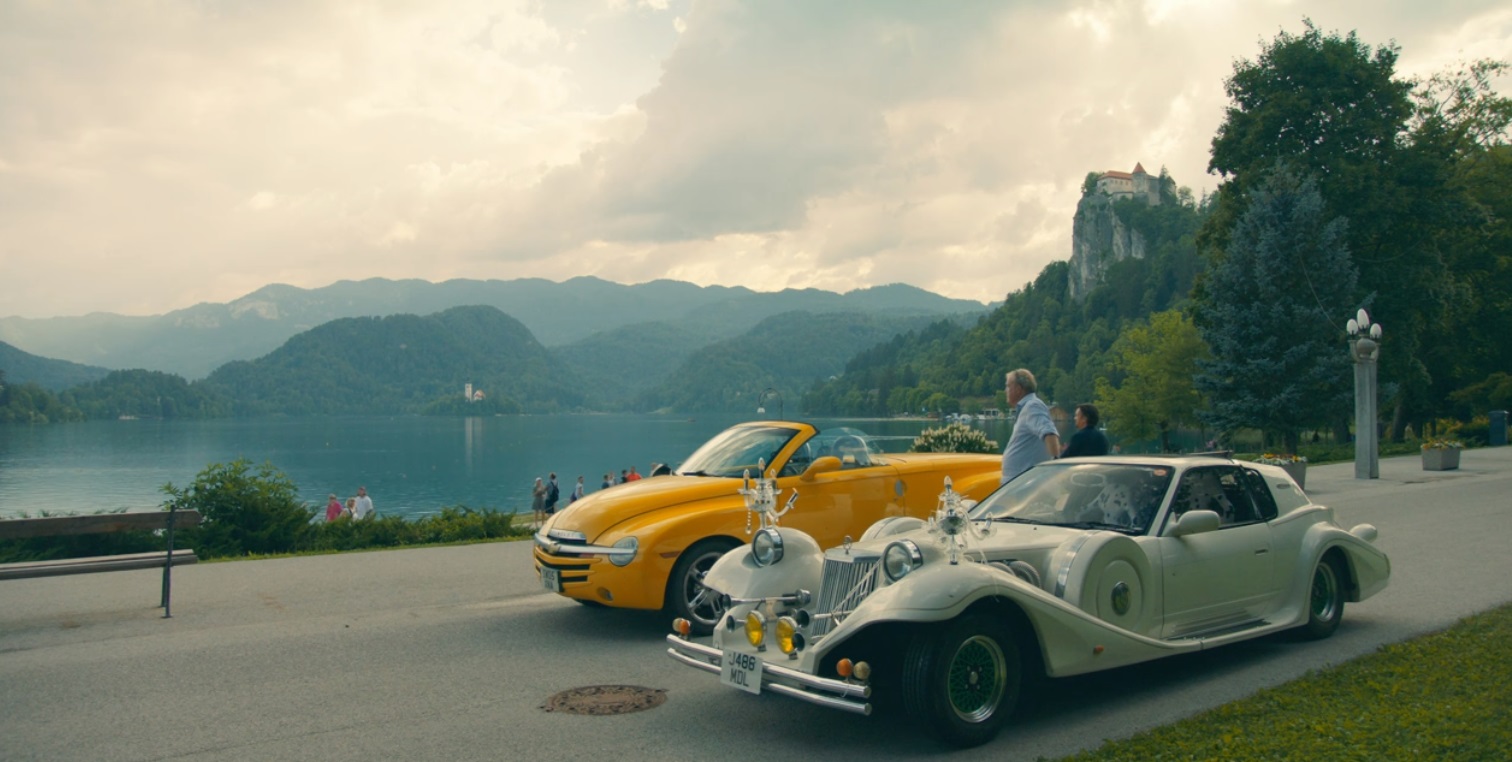
In their latest adventure-filled episode, “The Grand Tour: Eurocrash,” renowned presenters Richard Hammond, Jeremy Clarkson, and James May embark on an exhilarating journey across the captivating landscapes of Europe. Starting their epic road trip in the historic city of Gdańsk, Poland, the trio sets off on a high-octane adventure. From the picturesque streets of Długi Targ to the adrenaline-pumping Tor Poznań racing circuit, they experience the diverse beauty and thrilling experiences that Poland and neighbouring countries has to offer.
Westerplatte, Gdańsk, Poland (Starting point)
Google Maps Co-ordinates: 54.404939, 18.674144

Długi Targ 14-20, 80-828 Gdańsk, Poland
Google Maps Co-ordinates: 54.348216, 18.654491

Tor Poznań, Wyścigowa, Przeźmierowo, Poland
Google Maps Co-ordinates: 52.417036, 16.809261

Pomnik Chrystusa Króla, Sulechowska, Świebodzin, Poland
Google Maps Co-ordinates: 52.236967, 15.546491

GRAPE TOWN HOTEL, aleja Wojska Polskiego, Zielona Góra, Poland
Google Maps Co-ordinates: 51.942754, 15.453917

Stalag Luft III, Żagań, Poland
Google Maps Co-ordinates: 51.600425, 15.308769

Polonia Wax Museum Figury Woskowe, Floriańska, Kraków, Poland
Google Maps Co-ordinates: 50.063869, 19.942598

ARP Piestany Airport , ICAO
Google Maps Co-ordinates: 48.627610, 17.829378

Nordijski center Planica, Rateče, Rateče Planica, Slovenia (Nigel drives down a ski slope)
Google Maps Co-ordinates: 46.475635, 13.723440

Lake Bled, Bled, Slovenia
Google Maps Co-ordinates: 46.369150, 14.107946

Official Trailer
Release: 16th June, 2023
Watch on Amazon Prime

Subscribe For Access To New Content
Leave a reply cancel reply.
This site uses Akismet to reduce spam. Learn how your comment data is processed .
Recent posts
Road house (2024) film locations, old dads (2023) film locations, black mirror – loch henry filming locations.
Your go-to source for filming locations around the globe.
- Abandoned Places
- Celebrity Graves
- Celebrity Homes
- Celebrity Restaurants
- Cool Places
- Crash Sites
- Did You Know?
- Documentary
- Filming Location Available
- Grand Designs
- Internet Celebrity Homes
- London Filming Locations
- Movie Homes
- Music Video Locations
- Netflix Faves
- Podcast Scripts
- Royal Wedding
- Top Monthly Posts
Designed with WordPress
Discover more from Global Film Locations
Subscribe now to keep reading and get access to the full archive.
Type your email…
Continue reading

Famous Holocaust Sites You can Visit Around The World
In this guide, we provide you with information on some of the most well-known sites of the Holocaust which you can visit today including:
- Auschwitz 1,2 and 3
- Anne Frank’s House
The Holocaust Memorial Berlin
- Schindler’s Factory
Warsaw Ghetto
The Holocaust is one of the most unfathomable events in human history. Many say that it can never truly be appreciated or understood until you see some of these sites for yourself. It is also important to further educate yourself on the atrocious which were allowed to happen during this time, and what better way to visit the places where they took place.

Probably the most famous site is Auschwitz near Krakow, Poland . Auschwitz was a network of Nazi concentration camps and multiple extermination camps; this may come as a surprise as many believe Auschwitz to be a singular camp.
In reality, “Auschwitz” was split into Auschwitz I, which was the building mainly holding political prisoners, and Auschwitz-Birkenau, which was a combination of a concentration camp and an extermination camp which held predominantly Jews, as well as homosexuals and gypsies.
A visit to Auschwitz can put things into perceptive. The sheer scale of the camp will act as a reminder as to how real and how terrible the Holocaust was. The long train track upon arrival and the outline of the building can bring on shivers. You can go on guided tours of Auschwitz, which are both harrowing and informative.
If you do decide to go with an organised tour, you will have with you an expert guide or survivor, all the information and personal uncovered stories you need to further your understanding of the atrocities that took place there – along with transport between the different parts of the camp as they are actually relatively far away from each other.
Parts of Auschwitz, such as a number of the infamous gas chambers, were destroyed by the Nazis upon learning they had lost the war. Other parts remain intact, such as the dormitories known as barracks and the wooden shelves where people slept and thousands of prisoners were held in small spaces. Other features include the clock towers, the trains, train track and prison cells.
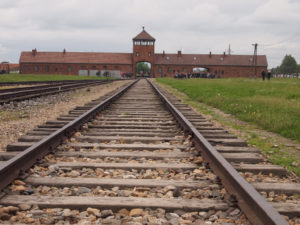
Auschwitz is notorious for the long train track that leads into the site:
At Auschwitz Majdanek, a separate site, much less has been destroyed and supposedly, it can be functioning and operating ‘within a day.’ Visitors can see gas chambers, barracks, crematoriums and a huge mountain of ashes – all located within suburban Kravow (the site is overlooking flats and residential homes).
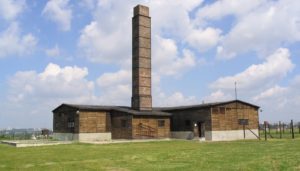
Auschwitz also features exhibitions which honour famous Jewish people as well as ones which display the actual inmate’s possessions, hair and millions of shoes – there is even a cabinet dedicated to prosthetic limbs taken from prisoners upon arrival in the camp.
Anne Frank’s House
In the heart of Amsterdam, Holland is Anne Frank’s house and her family lived in hiding during World War II to avoid persecution. Living with them there was a family called the van Pels and later, a man called Fritz Pfeffer joined the two families.
Anne Frank is famous for keeping a diary during her time in hiding, documenting her thoughts and feelings, which were at times surprisingly and endearingly optimistic.
Tragically, the group’s whereabouts were told to the Nazis and this betrayal resulted in their transfer to concentration camps. This sort of betrayal was very common in Nazi-occupied areas and unfortunately led to the death of so many Jews and other persecuted groups. Anne died in Belsen in 1945, just days after she found her sister Margo had died of disease, but her diary was discovered and published by her father, Otto, who survived the Holocaust.
Her house is now a museum which is hugely popular. Visitors are able to see the moving bookcase which they lived behind, walk through the cramped secret annex and see the conditions they lived in simply to survive. The museum has collected various objects and photographs which belonged to the Frank and van Pels family and the original of Anne Frank’s diary is on display to see.
The Holocaust Memorial, also known as the Memorial to the Murdered Jews, situated in Berlin is dedicated to commemorating the genocide of the Jewish people as directed by the Nazi Party.
It is presented with thousands of concrete slabs, over 6 feet high and positioned like dominos at different levels, to give perspective, turbulence and uncertainty. It is a place of contemplation, remembrance and also warning.
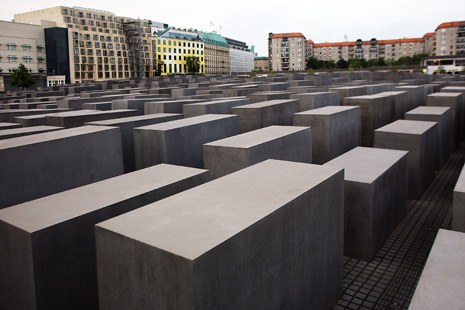
Schindler’s Factory
You can visit the site of Oskar Schindler’s factory where he employed Jews, offering them protection from the Nazi Party’s hunt. Schindler was a German Businessman living in Krakow, Poland.
This was not a hiding situation, the Nazis actually knew that he was employing Jews, but he had a good relationship with the SS and claimed he needed them because they cost less and their labour was “necessary for the German war effort”. As a result, thousands upon thousands of Jews which worked in his factory avoided being transported to extermination camps.
His former-factory has been turned into a museum open to the public. The museum is dedicated to educating people on the wartime experiences in Krakow under the five-year Nazi occupation during World War II.
In addition, parts of the museum are dedicated to Schindler and the workers he housed. The rest of the museum shows pre-war Krakow, the turn of the German invasion in 1939, Krakow under Nazi occupation. It also details everyday life of locals, family life as well as the resistance movement and it ends with the Soviet capture of the city.
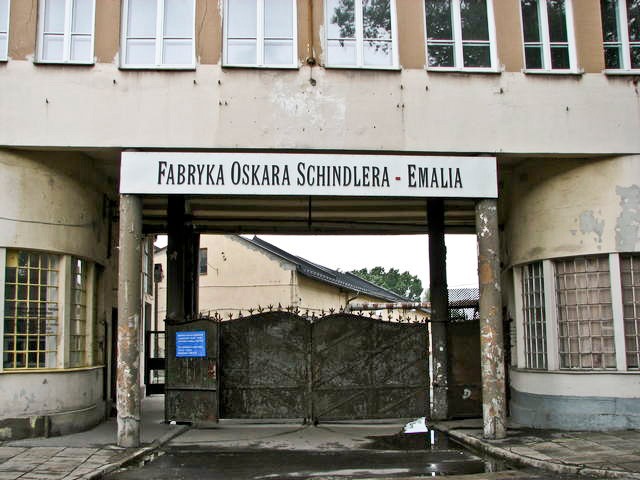
In the Holy Land of Jerusalem, you will find Yad Vashem which translates to ‘the hand of God.’ It is a huge and very impressive museum which is a living tribute and memorial to the victims of the Holocaust, who did not receive a burial.
Yad Vashem aims to keep the conversation going. The exhibits feature photographic accounts written and spoken by victims, remains from survivors, art installations and information panels.
There is a side dedicated to children of the Holocaust which is complete darkness – highlighting that as children, we do not see things clearly.
The site is modern and shows very impressive architecture and creativity. There is also a very historical aspect to the centre, which is highly educational.

Warsaw in Poland was home to the largest and deadliest Nazi-cultivated Ghettos in Europe. Ghettos were segregated areas where Jewish people were forced to live when under Nazi occupation. At its highest capacity, the Warsaw Ghetto housed an estimated 380,000 people, which works out to about 8 people per room.
Today, you can visit the site which is commemorated by “The Footbridge of Memory”, which was the bridge which linked the two smaller Ghettos together at the time.
Pictures of the victims are displayed on the buildings for you to see as you walk down the streets.
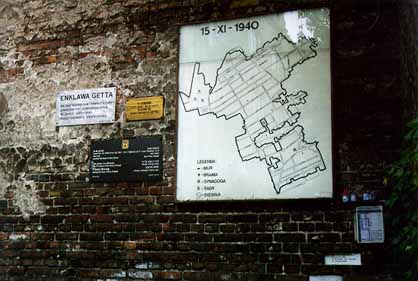
Previous Post A Guide to Female Nazi Guards
Next post holocaust films based on true stories, about holocaust matters.
Holocaust Matters is an interactive educational tool for anyone interested in the Holocaust including schools and those with a professional or personal research interest. It is run by the family of Holocaust survivor Dr Ernst Israel Bornstein to showcase excerpts of his memoir ‘The Long Night’ which tells of his miraculous survival from seven Nazi labour and death camps during World War II.
Users can explore and learn from the historical topics and universal themes within the book.
As well as being a historical source Ernst’s survival story has thrown up sensational new perspectives on the Holocaust and how history is remembered or forgotten to this day.
Without the words as his legacy his story would be lost.
Navigation Menu
- Explore & Learn
- Ernst Israel Bornstein
- Surviving Seven Camps
- Read The Book
Twitter Feed
© 2018 Holocaust Matters. Designed by Tudor Lodge Consultants
- Explore Universal Themes
- Camp hierarchy
- Holocaust remembrance
- Jewish life in camps
- Perpetrator
- Christianity
- Crematorium
- Death march
- Ernst Bornstein’s family
- Female Nazi Guards
- Forced labour
- Hidden Child
- Holocaust Selection Process
- Infamous Nazi Party Members
- Judenältester
- Meister Wilhelm Hermann
- Resettlement of Jews
- Righteous Gentiles
- Sabbath and festivals
- Why Did Hitler Not Like the Jews?
- Yellow star
- Learn about Holocaust Topics
- The Final Solution?
- Search by location
- Grünheide camp
Markstädt camp
Fünfteichen camp, gross rosen camp.
- Flossenbürg camp
- Leonberg camp
Mühldorf camp
- Video Archive
- Endorsements
- Watch The Long Night
- Speak to Noemie
Although Ernst was never an inmate at the notorious Auschwitz camp he relays his fear of being sent there. His parents and two younger sisters perished at Auschwitz. The camp’s deadly reputation was well-known amongst inmates of other camps. Nearly one million Jews were murdered at Auschwitz along with tens of thousands of Poles, Roma and people of other nationalities.
Find out more
Zawiercie in southern Poland, was Ernst Bornstein’s hometown. On the eve of the WWII there were 7,000 Jews in Zawiercie – about a quarter of its residents. They made their living primarily from trade, crafts, the clothing industry and the metal industry. The city had a traditional “cheder” (religious primary school), a Talmud Torah, and a school and kindergarten.
Grünheide forced labour camp
Ernst was dragged from his family home on 25th March 1941 and sent to Grünheide camp in modern-day Sieroniowice, Poland. Nothing is thought to remain of the camp apart from a hidden memorial.
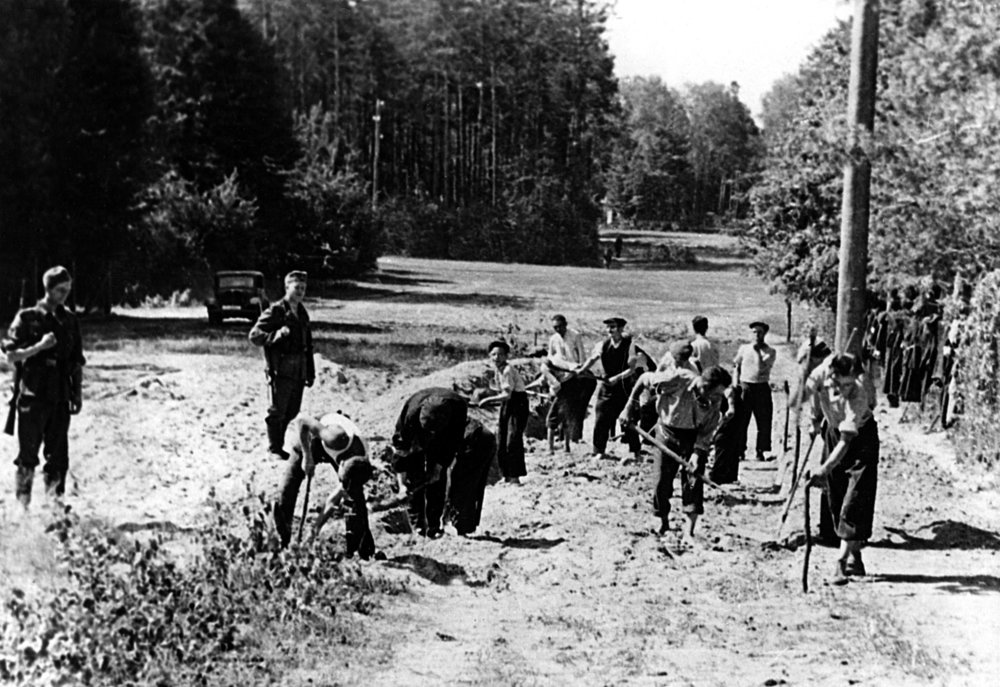
Markstädt was one of the largest Schmelt forced labor camps for Jews. Located 22 kilometers southeast of Wrocław (Breslau), it was established for Alfried Krupp’s artillery factory the “Bertha-Werk”.
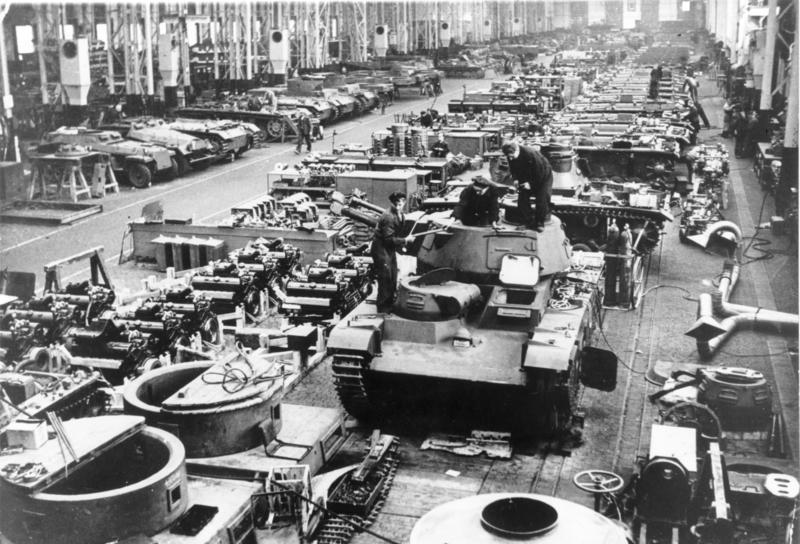
Fünfteichen was the largest subcamp in the Gross Rosen system. Most of the prisoners worked for the Krupp Factory, manufacturing 75mm and 150mm cannons as well as torpedo launchers. Prisoner beatings by SS men were a daily occurrence. Many prisoners could not stand the conditions prevailing in camp and committed suicide.
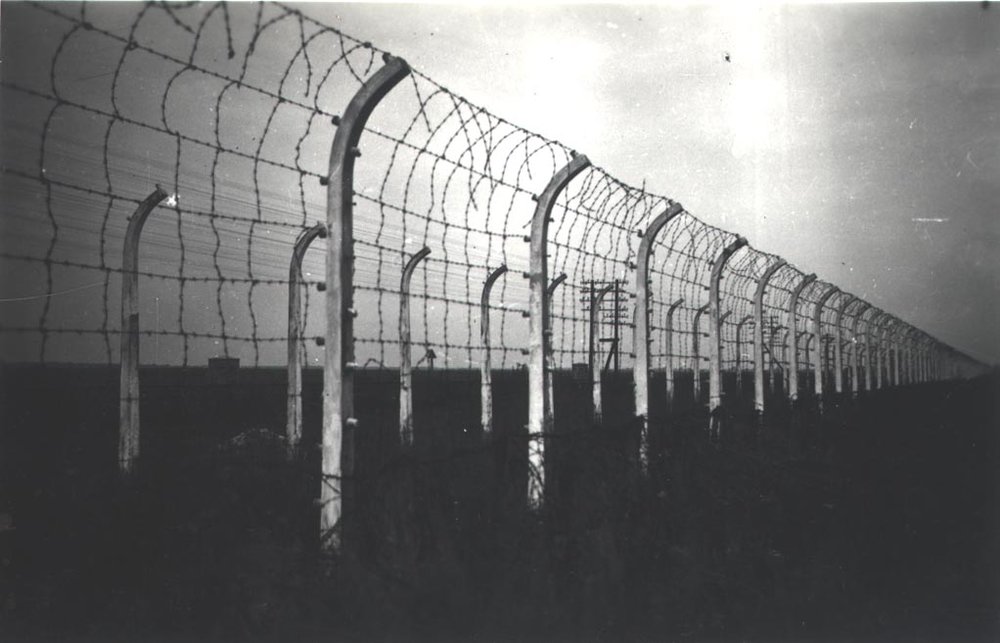
Gross Rosen concentration camp was located in modern-day Rogoznica in Poland. At its peak activity in 1944, the Gross Rosen complex had up to 100 subcamps located in eastern Germany, Czechoslovakia, and on the territory of occupied Poland. The population of all Gross Rosen camps at that time accounted for 11% of the total number of inmates incarcerated in the Nazi concentration camp system. There is now a museum on the site.
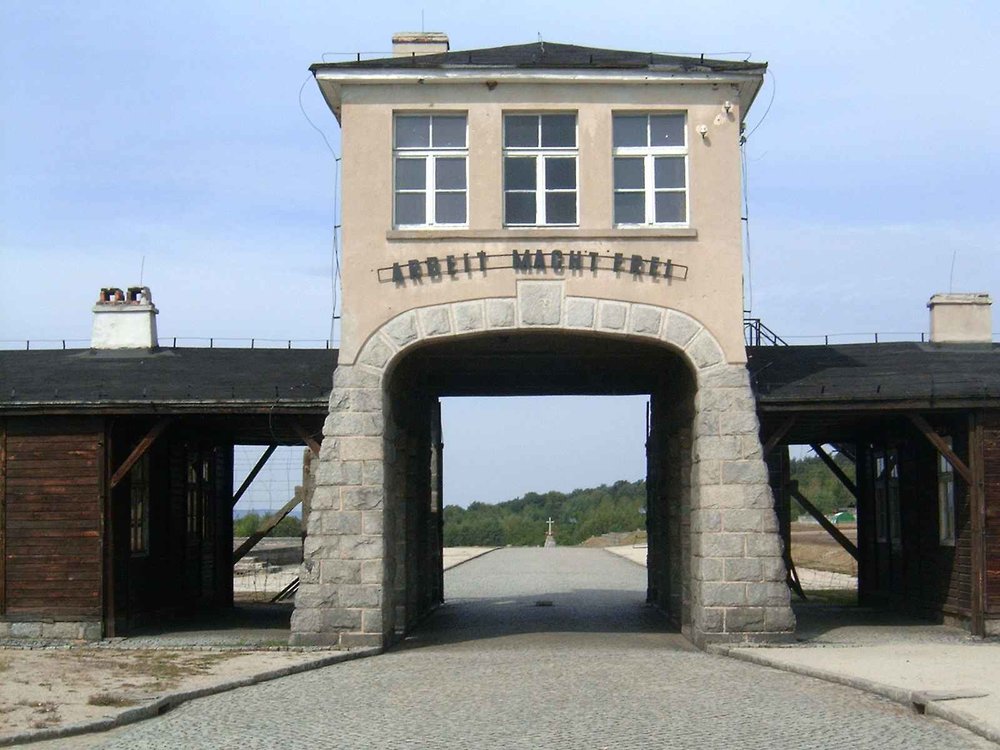
Flossenbürg Camp
Flossenbürg was a Nazi German concentration camp built in May 1938. Until its liberation in April 1945, more than 96,000 prisoners passed through the camp, around 30,000 of whom died there.
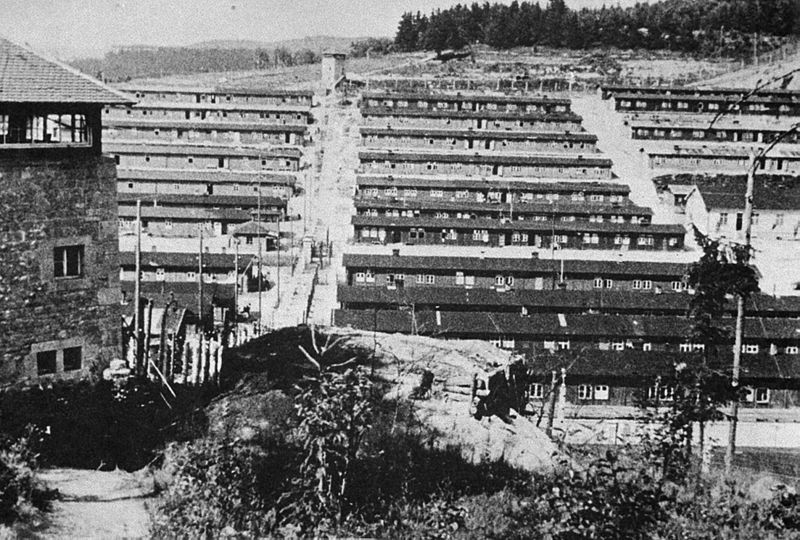
Leonberg Camp
From spring 1944 to April 1945 there was an outpost of the Natzweiler concentration camp run by the “SS” in Leonberg. Prisoners from 24 European countries, mainly from Poland, the USSR, France, Hungary, the Balkans and Germany were held captive in the shacks working almost exclusively for the Messerschmitt AG company making wings for the ME 262 jetfighter.
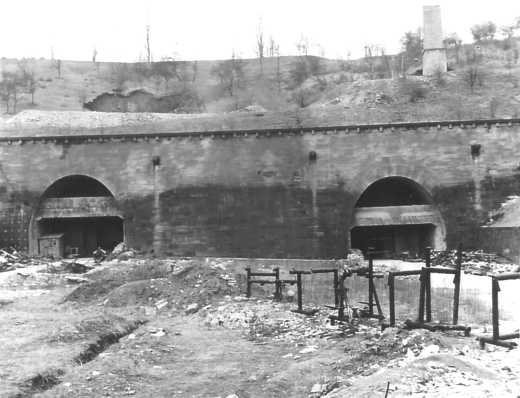
In mid-1944, the SS established the Mühldorf camp complex in Bavaria as a satellite system of the Dachau concentration camp to provide labour for an underground installation for the production of the Me-262 jet fighter.
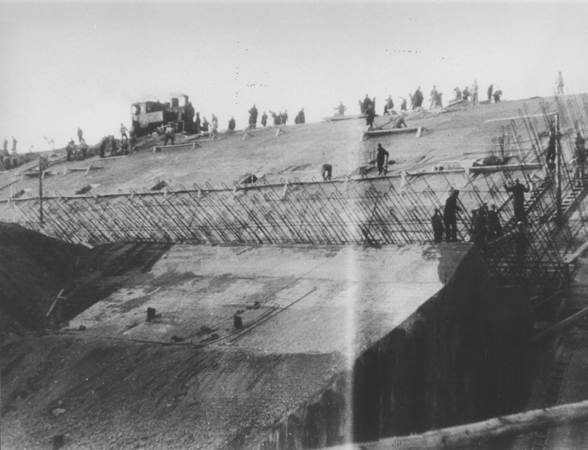
Grand Tour Release Date: When’s The Next Episode Coming Out?
The Grand Tour is one of the most popular car shows on television, featuring three of the world’s most famous car enthusiasts, Jeremy Clarkson , Richard Hammond, and James May . The show has been on hiatus for some time, but last year they filmed the next episode in Eastern Europe. In this article, we will discuss the release date, story, and cars featured in the Grand Tour Season 5 Special, which is set in Eastern Europe.
Table of Contents
Is The Grand Tour cancelled?
While it’s been confirmed by the presenters that the show isn’t cancelled, The Grand Tour may be taking an extended break until 2024 . This update comes from a source closely connected to the show which recently shared this news.
Since the show’s transition from a tent and live audience format to more elaborate and highly produced road trip episodes, The Grand Tour has been releasing special episodes sporadically over the past few years. However, recent reports suggest that fans of the show may have to wait even longer than expected for new episodes to be released.
Jeremy Clarkson, Richard Hammond, and James May were in the process of filming a new episode in Europe during mid-2022. However, with episodes being reportedly pushed back until 2024, fans of the show will have to exercise patience and wait for new content.
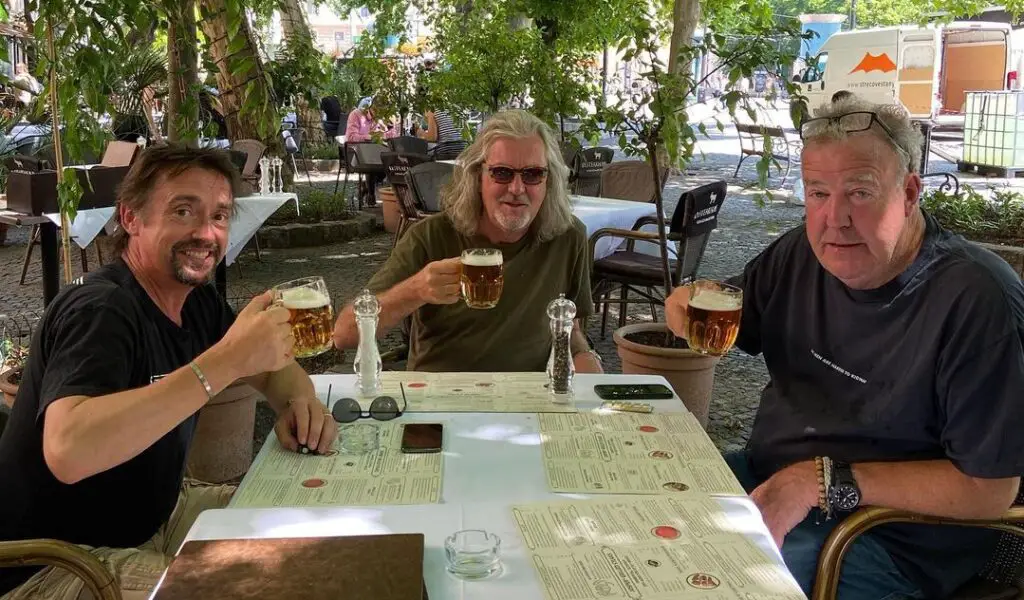
Next Episode Release Date
Because the next episode is on a reported hiatus, we have no idea when it will be released.
This is a shame, as just after filming the Eastern European Special, Jeremy Clarkson was involved in an interview where he talked about what they’d been doing in the European countries, as well as when it could reach Prime Video.
“Well, we came in through the mountains from Hungary, so it’s just straight away very pretty. And then it stays very pretty to here. So it’s just very pretty,” he said. “Well, this is, it is actually the finish point for a long – about a 2,200 kilometer drive from Gdansk at the top of Poland. All the way down to Krakow, Czech Republic, Slovakia, Hungary, and then here.”
He was further asked how long it would be before its release:
“A very long time. Is it six months, perhaps? Six months,” he tells the interviewer.
Unfortunately, if this was true, the episode would already have already been released to Prime Video, so we’re thinking he may have misspoken here.
Eastern Europe
The Grand Tour Season 5 Special will take place in Eastern Europe, a region that is known for its stunning scenery and fascinating culture. The episode will feature the hosts driving through several countries in the region, including Hungary, Slovakia, and Poland. The team has promised that the episode will be filled with exciting challenges, stunning locations, and of course, plenty of car-related shenanigans.
In the Summer of 2022, The Grand Tour team returned from Europe after a long stint of filming. Travelling from Poland to Slovenia, the trio drove 2,000km to bring us what looks to be the best episode so far.
Arriving in Gdansk
Clarkson, Hammond, and May leave Oxford International Airport on June 19th on a private jet. They landed in Gdansk , Poland soon after, where their journey began.
Here, they joined their three cars, a Chevrolet SSR, a Crosley Convertible, and a Mitsuoka Le-Seyde which they took to Długia Street. According to Google Maps, this is completely pedestrianised, but according to local reports, the filming was done under secrecy with not even the local law enforcement knowing about the team and their plans.
This area is one of the most popular tourist destinations in the city leading from the Golden Gate to Długi Targ square. It looks like the trio drove the length of this, as well as around the post-shipyard areas, the port, and Westerplatte.
This is where our assumptions begin. Gdansk is home to where the first gunshots of World War II were shot, and this theme continues to a few of the locations the team travels to later in the week of filming.
Before they left the city, a hot rod based on a 1959 Ford Popular was also spotted. This will become more prevalent later on.
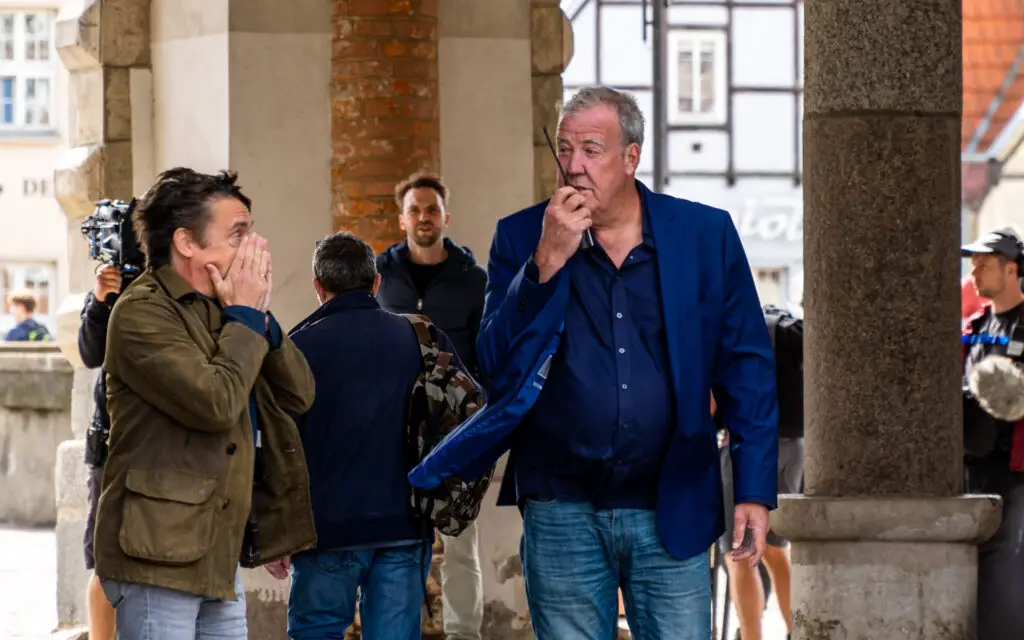
Did The Grand Tour Travel to Ukraine?
It was a couple of days into filming when fans started wondering if The Grand Tour was heading to Ukraine. As we know, Jeremy has been very passionate about supporting the people of Ukraine since the war with Russia started, so at this point, it wasn’t such a stretch, especially when Jeremy showed his support of driving armoured vehicles into the country on Twitter.
As we now know, the team didn’t make it to Ukraine. Instead, they travelled South-West.
Zielona Gora – The Grand Tour Visits Vineyards
We followed the trio as they travelled to Zielona Gora, a city in the Lubusz province of the country. It’s known for its endless vineyards so it wouldn’t be a surprise if we see Clarkson, Hammond and May tasting some wine at this point of the episode.
It also has connections to WWII, with it being reported that 30% of the city had been damaged by the Germans.
Richard Hammond Crashes At Tor Poznań Racetrack
Continuing West, the trio were spotted at a racetrack. I did some investigation work and figures out that this was the Tor Poznań racetrack in the city of Poznan. The track almost became part of the F1 calendar in the ’80s thanks to its connection to Polish F1 driver Robert Kubica, but this never came to fruition.
This didn’t stop Clarkson, Hammond and May from driving some open-wheeled race cars around the track. As you heard, Richard Hammond lived up to his antics and crashed into a barrier . He was unhurt but the car sustained a little front-end damage. According to our sources, this was caused by the engine seizing. Hammond was seen next to the wreck in a racing suit with May standing next to him looking a bit disappointed in his fellow presenter.
Judging from a photo of Jeremy with a stopwatch hanging around his neck, it looks like they were doing timed laps here.
James May Breaks Down
As the trio headed from Poznan to Lower Silesia, Hammond’s bad luck was passed to James May as his Crosley broke down . We don’t know what happened to the car, but it was pushed onto the back of a trailer as May waited for a replacement.
What was that replacement? The hot rod, of course.
The Grand Tour Visits a German Concentration Camp
Next stop: Jeremy posted a photo to his Instagram account of Stalag Luft 3, a German concentration camp in the town of Sagan, Lower Silesia. This continues the WWII theme and should act as a sobering moment in the episode. Around this time the team also visited Krakow.
Leaving The Country and Entering Slovakia
After a brief drive through Czechia, the trio was seen driving through Slovakia, the country where there are the most cars produced per capita. Here they visited Patak Motors who showed the presenters their car, the Roadster.
Jeremy Clarkson Drives The Skoda 1100 OHC Spider
Still in Slovakia, Jeremy gets into the driver’s seat of a Skoda 1100 OHC Spider , which he describes as “absolutely fantastic”, at Piešťany Airport. At the same time, James May was spotted driving the KleinVision AirCar .
The Road To The Finale
The trio continue their travels through Bratislava where they go cycling by the Danube River before continuing to Hungary, and eventually Slovenia.
Slovenia, The Final Destination Of The Grand Tour European Special
Here, Clarkson and Hammond were spotted on Lake Bled without May in the northwest of Slovenia in the Julian Alps. Again, we don’t quite know what they were doing, but they were seen rowing a boat onto the lake before Hammond stood up, rocking the boat.
Despite this being an incredibly popular area for tourists, barely any footage from around the area was taken which is a shame.
The Cars of the next Grand Tour Special
Jeremy clarkson – mitsuoka le-seyde.
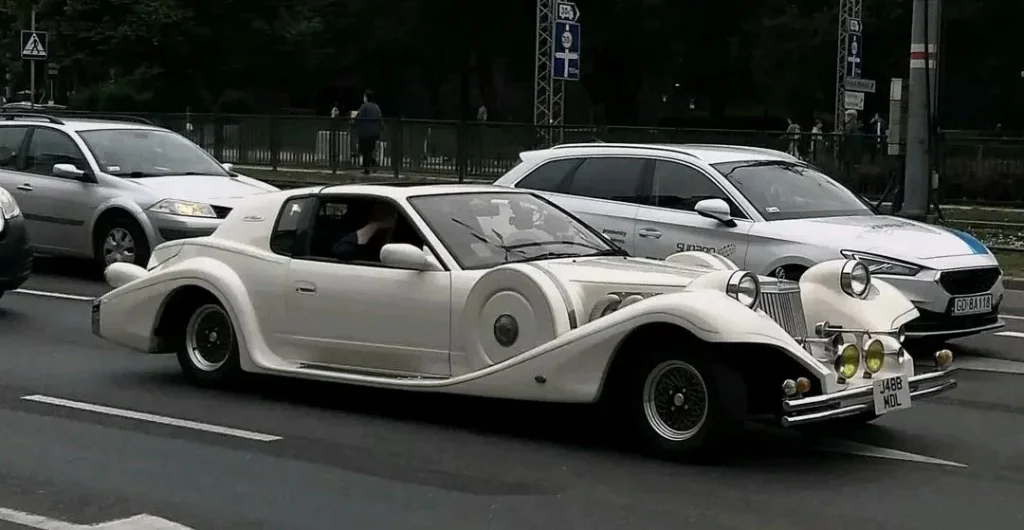
Based on a Nissan Silvia S13, this sports car is made to resemble a Zimmer Golden Spirit. under the body panels it retains a lot of the same running gear as the iconic Japanese sports car, but as these cars are so tunable, it wouldn’t be a surprise to find out it’s been modified in some way.
In an off-white, it’s definitely the most identifiable of the three cars used in the upcoming episode.
Richard Hammond – Chevrolet SSR
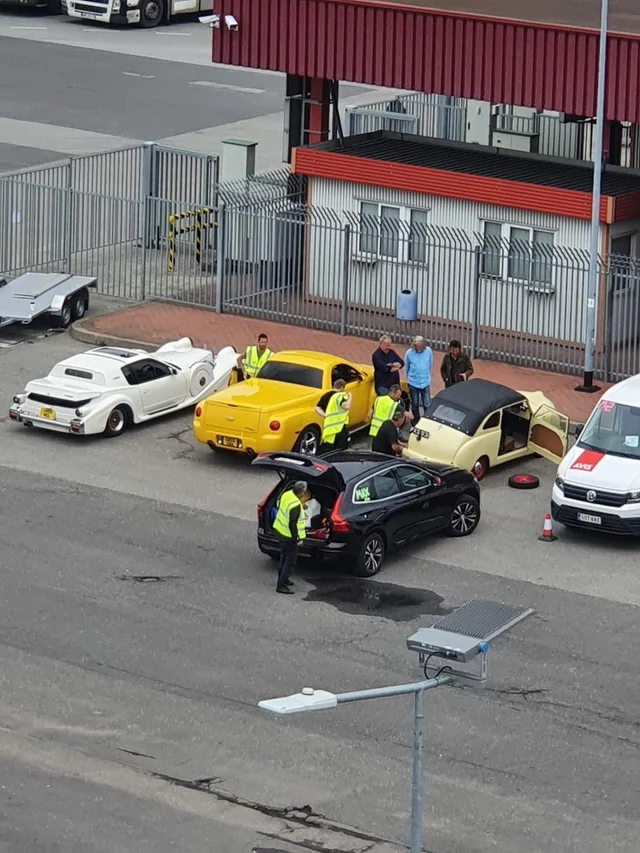
The Chevrolet SSR is very, very cool. Standing for Super Sport Roadster, the SSR is powered by either a 300 horsepower or 380 horsepower V8 depending on the year. The year of this exact car I can’t figure out, but it’s safe to say these things were negatively reviewed when they were revealed. But its retro shape has kind of stood the test of time and I’m really excited to hear what the show’s resident American thinks of this interesting but impractical car.
James May – Crosley Convertible
The Crosley Convertible is yet another car from America which tried to capitalise on the lack of cars available after the war. The owner of Crosley, Powel Crosley, Jr., actually made his money from refrigerators and radios before WW2, but 1946 brought this horrible thing. Creating just 26 and a half horsepower from its 725cc engine, this slab-sided vehicle likely won’t be fast enough to stay in front of the camera for too long.
Although this might actually be a good thing if you know the mess James got into the last episode …
We spotted this car broken down later in the process of filming, so it will be interesting to see if it makes it.
Backup Car – 1959 Ford Popular
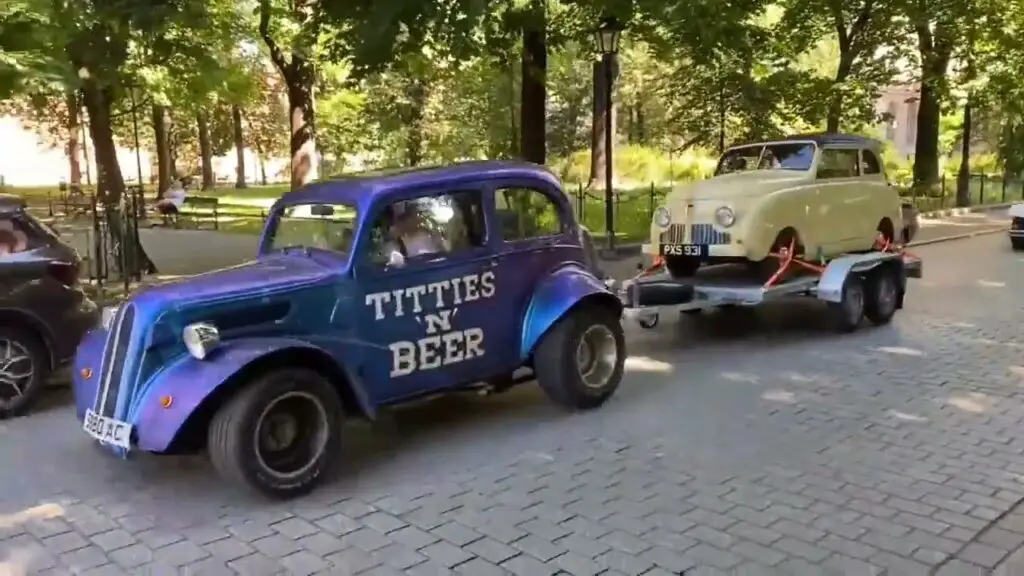
A hot rod, based on a 1959 Ford Popular , can be seen from photos of The Grand Tour trio taken during filming. Painted in a pearlescent blue with writing down the side, this car is certainly a standout part of the episode. And after May breaks down , he can be seen driving it later during filming.
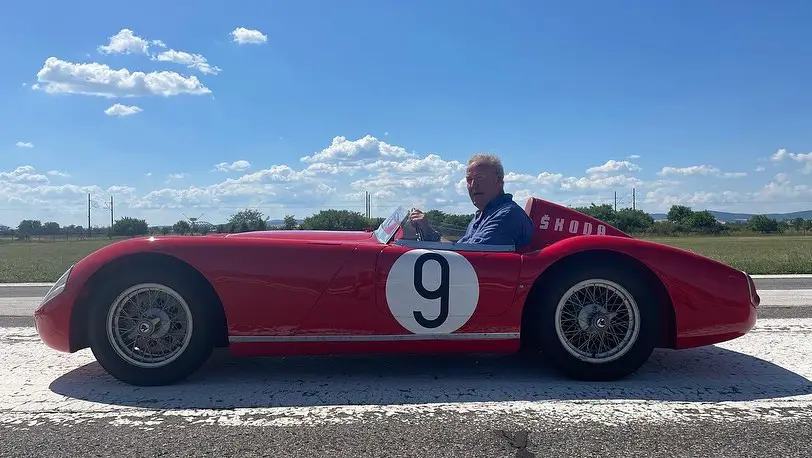
The 110 OHC Spider, or “Red Racer”, was released in 1956. The idea for the car was only imagined a number of months before this, but Skoda was quickly able to spin up production to produce this sleek, low-slung, high-performance car.
And that it was, despite wielding only a 1.1-litre four-cylinder engine producing 85 horsepower, it could reach 124mph at full chat. This was a lot of power at the time and the reason? High-octane aviation fuel. Who knew Skoda used to be so cool?
Jeremy takes this for a spin , but we’re unsure exactly where.
James May Flies The AirCar
Similarly to an old Top Gear episode, James May has apparently taken to the air in the AirCar, a car that’s capable of flight.
Powered by a 1.6-litre BMW engine, the AirCar has been issued a certificate of airworthiness by Slovakia’s Transport Authority. the Slovakian company achieved its first intercity flight in June 2021 where it hit speeds of 170 kilometres per hour (105 mph) over a distance of 1,000km. Once on the land, a single press of a button transforms it into a car.
KleinVision, the makers of AirCar, said the following:
“Based on the fact that the aircraft met the conditions of national regulations set for individually manufactured aircraft and the required level of safety was demonstrated, the Slovak Transport Authority (STA) has issued a special certificate of airworthiness. “After obtaining the type certificate, it can manufacture the aircraft commercially.”
Alex Harrington
Chevrolet corvette suv could take the fight to ferrari, lamborghini, and aston martin, romain grosjean's burnt 2020 haas from awful crash to go on display in madrid, related articles, was the mozambique special insensitive and offensive, top gear makes dig at jeremy and co., top gun 2: maverick trailer release shows maverick flying futuristic jet.
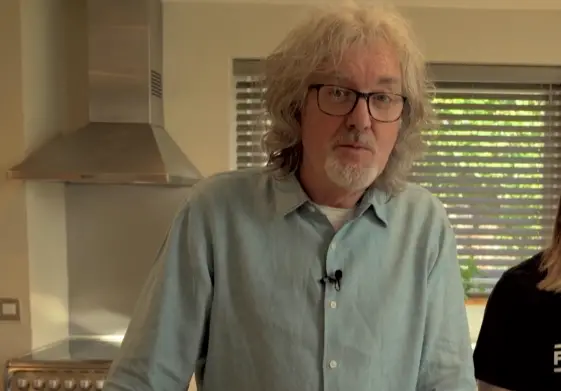
Watch James May Cook The Best Bacon Sandwich… In The World
- History Classics
- Your Profile
- Find History on Facebook (Opens in a new window)
- Find History on Twitter (Opens in a new window)
- Find History on YouTube (Opens in a new window)
- Find History on Instagram (Opens in a new window)
- Find History on TikTok (Opens in a new window)
- This Day In History
- History Podcasts
- History Vault
By: History.com Editors
Updated: January 24, 2024 | Original: December 15, 2009

Auschwitz, also known as Auschwitz-Birkenau, opened in 1940 and was the largest of the Nazi concentration and death camps. Located in southern Poland, Auschwitz initially served as a detention center for political prisoners. However, it evolved into a network of camps where Jewish people and other perceived enemies of the Nazi state were exterminated, often in gas chambers, or used as slave labor. Some prisoners were also subjected to barbaric medical experiments led by Josef Mengele (1911-79). During World War II (1939-45), more than 1 million people, by some accounts, lost their lives at Auschwitz.
In January 1945, with the Soviet army approaching, Nazi officials ordered the camp abandoned and sent an estimated 60,000 prisoners on a forced march to other locations. When the Soviets entered Auschwitz, they found thousands of emaciated detainees and piles of corpses left behind.
Auschwitz: Genesis of Death Camps
After the start of World War II , Adolf Hitler (1889-1945), the chancellor of Germany from 1933 to 1945, implemented a policy that came to be known as the “Final Solution.” Hitler was determined not just to isolate Jews in Germany and countries annexed by the Nazis, subjecting them to dehumanizing regulations and random acts of violence. Instead, he became convinced that his “Jewish problem” would be solved only with the elimination of every Jew in his domain, along with artists, educators, Romas, communists, homosexuals, the mentally and physically handicapped and others deemed unfit for survival in Nazi Germany.
Did you know? In October 1944, a group of Auschwitz "Sonderkommando," young Jewish males responsible for removing corpses from crematoriums and gas chambers, staged a revolt. They assaulted their guards, using tools and makeshift explosives, and demolished a crematorium. All were apprehended and killed.
To complete this mission, Hitler ordered the construction of death camps. Unlike concentration camps, which had existed in Germany since 1933 and were detention centers for Jews, political prisoners and other perceived enemies of the Nazi state, death camps existed for the sole purpose of killing Jews and other “undesirables,” in what became known as the Holocaust.
Auschwitz: The Largest of the Death Camps
Auschwitz, the largest and arguably the most notorious of all the Nazi death camps, opened in the spring of 1940. Its first commandant was Rudolf Höss (1900-47), who previously had helped run the Sachsenhausen concentration camp in Oranienburg, Germany. Auschwitz was located on a former military base outside Oswiecim, a town in southern Poland situated near Krakow, one of the country’s largest cities. During the camp’s construction, nearby factories were appropriated and all those living in the area were forcibly ejected from their homes, which were bulldozed by the Nazis.
Auschwitz originally was conceived as a concentration camp, to be used as a detention center for the many Polish citizens arrested after Germany annexed the country in 1939. These detainees included anti-Nazi activists, politicians, resistance members and luminaries from the cultural and scientific communities. Once Hitler’s Final Solution became official Nazi policy, however, Auschwitz was deemed an ideal death camp locale. For one thing, it was situated near the center of all German-occupied countries on the European continent. For another, it was in close proximity to the string of rail lines used to transport detainees to the network of Nazi camps.
However, not all those arriving at Auschwitz were immediately exterminated. Those deemed fit to work were employed as slave labor in the production of munitions, synthetic rubber and other products considered essential to Germany’s efforts in World War II.
Auschwitz and Its Subdivisions
At its peak of operation, Auschwitz consisted of several divisions. The original camp, known as Auschwitz I, housed between 15,000 and 20,000 political prisoners. Those entering its main gate were greeted with an infamous and ironic inscription: “Arbeit Macht Frei,” or “Work Makes You Free.”
Auschwitz II, located in the village of Birkenau, or Brzezinka, was constructed in 1941 on the order of Heinrich Himmler (1900-45), commander of the “Schutzstaffel” (or Select Guard/Protection Squad, more commonly known as the SS), which operated all Nazi concentration camps and death camps. Birkenau, the biggest of the Auschwitz facilities, could hold some 90,000 prisoners.
It also housed a group of bathhouses where countless people were gassed to death, and crematory ovens where bodies were burned. The majority of Auschwitz victims died at Birkenau. More than 40 smaller facilities, called subcamps, dotted the landscape and served as slave-labor camps. The largest of these subcamps, Monowitz, also known as Auschwitz III, began operating in 1942 and housed some 10,000 prisoners.
Life and Death in Auschwitz
By mid-1942, the majority of those being sent by the Nazis to Auschwitz were Jews. Upon arriving at the camp, detainees were examined by Nazi doctors. Those detainees considered unfit for work, including young children, the elderly, pregnant women and the infirm, were immediately ordered to take showers. However, the bathhouses to which they marched were disguised gas chambers. Once inside, the prisoners were exposed to Zyklon-B poison gas. Individuals marked as unfit for work were never officially registered as Auschwitz inmates. For this reason, it is impossible to calculate the number of lives lost in the camp.
For those prisoners who initially escaped the gas chambers, an undetermined number died from overwork, disease, insufficient nutrition or the daily struggle for survival in brutal living conditions. Arbitrary executions, torture and retribution happened daily in front of the other prisoners.
Some Auschwitz prisoners were subjected to inhumane medical experimentation. The chief perpetrator of this barbaric research was Josef Mengele (1911-79), a German physician who began working at Auschwitz in 1943. Mengele, who came to be known as the “Angel of Death,” performed a range of experiments on detainees. For example, in an effort to study eye color, he injected serum into the eyeballs of dozens of children, causing them excruciating pain. He also injected chloroform into the hearts of twins to determine if both siblings would die at the same time and in the same manner.
Liberation of Auschwitz: 1945
As 1944 came to a close and the defeat of Nazi Germany by the Allied forces seemed certain, the Auschwitz commandants began destroying evidence of the horror that had taken place there. Buildings were torn down, blown up or set on fire, and records were destroyed.
In January 1945, as the Soviet army entered Krakow, the Germans ordered that Auschwitz be abandoned. Before the end of the month, in what came to be known as the Auschwitz death marches, an estimated 60,000 detainees, accompanied by Nazi guards, departed the camp and were forced to march to the Polish towns of Gliwice or Wodzislaw, some 30 miles away. Countless prisoners died during this process; those who made it to the sites were sent on trains to concentration camps in Germany.
When the Soviet army entered Auschwitz on January 27, they found approximately 7,600 sick or emaciated detainees who had been left behind barbed wire. The liberators also discovered mounds of corpses, hundreds of thousands of pieces of clothing and pairs of shoes and seven tons of human hair that had been shaved from detainees before their liquidation. According to some estimates, between 1.1 million to 1.5 million people, the vast majority of them Jews, died at Auschwitz during its years of operation. An estimated 70,000 to 80,000 Poles perished at the camp, along with 19,000 to 20,000 Romas and smaller numbers of Soviet prisoners of war and other individuals.
Auschwitz Today
Today, Auschwitz is open to the public as the Auschwitz-Birkenau Memorial and Museum . It tells the story of the largest mass murder site in history and acts as a reminder of the horrors of genocide.
Images from the Death Camps

Sign up for Inside History
Get HISTORY’s most fascinating stories delivered to your inbox three times a week.
By submitting your information, you agree to receive emails from HISTORY and A+E Networks. You can opt out at any time. You must be 16 years or older and a resident of the United States.
More details : Privacy Notice | Terms of Use | Contact Us
Rated 98% based on 1029 reviews

UK 0345 475 1815 USA (toll free) 877‑209‑5620 International 00 44 345 475 1815 [email protected] Rated 98% on feefo
Sign-in Latest News Subscribe Request Brochure
- Future Planning
- Military History and Battlefield Tours
- Classical History and Archaeological Tours
- Holocaust Tours
- General History Tours
- Experience Tours
- Walking Tours
- Early Periods
- 17th & 18th Century
- Victorian Era
- First World War
- Second World War
- Cross-Periods
- Destinations
- Our Expert Historians
- Historians Q&A
- Historical Tailor Made Tours
- School Tours
- Battlefield Studies
- Testimonials
- What to Expect
- Activity Levels
- Tour Diaries & Images
- Our Library
- Frequently Asked Questions
- Work For TCE
- General Booking Conditions
- Download Booking Form
- Tours by Date
- Tours by Theme
- Tours by Period
- Tours by Destination
- Latest News
- Request Brochure
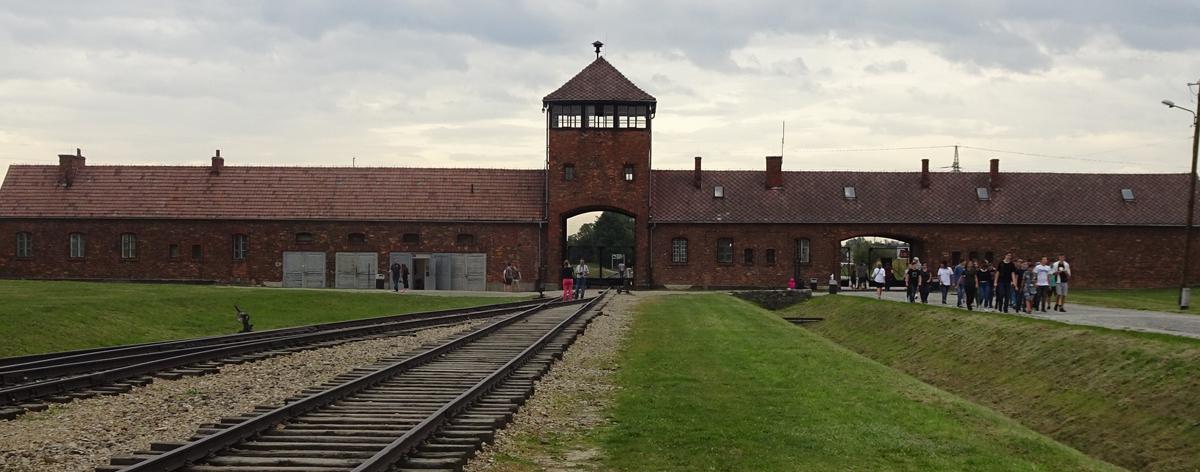
- The Holocaust
Poland and the Nazi Death Camps
Experience Tours General History Tours Holocaust Tours
26th June - 3rd July 2024 (8 Days)
Expert Historian : Professor Alexander Korb
Tour price: £2,800
click here to book
MORE DATES AVAILABLE BELOW
Your Holiday Essentials
26th June - 3rd July 2024 (8 Days)
4-star hotels, meals as indicated,
drinks with dinner, all entrance
fees, tour manager and expert
historian throughout, all internal
travel, optional travel from UK.
Activity Level : 2
Standard price: £2,550
Incl. travel from UK: £2,800 Room sole occupancy supplement: £315 Non-refundable deposit: £275
Booking open
Interested in this tour but not ready to book? Register your interest using the link below and we will keep you updated on the progress of the tour.
click here to register your interest
28th August - 4th September 2024 (8 Days)
Expert Historian : Dr Isabel Wollaston
Use the button below to be put on the waiting list
2nd - 9th October 2024 (8 Days)
Expert Historian : Martin Winstone
Last few places
Tour Introduction
In this 8-day tour to Poland, we visit the sites of the former ghettos in Warsaw, Lublin and Krakow alongside four of the concentration and death camps - Treblinka, Majdanek, Belzec and Auschwitz-Birkenau - that played such a significant role in this genocide. We look at the struggle of both the Jews and the Poles against their oppressors,visiting the scenes of Ghetto Uprising in 1943 and the memorial to the Warsaw Rising in 1944. You will see the shift from complete physical destruction of ghetto and camp to the actual remnants due to the rapid advance of the Soviets. However, the tour is not limited to the serious and emotive history of the Holocaust, with its clear message for future generations. We also enjoy expert guided tours of the historic cities of Warsaw and Krakow. We sample much of the local culture and visit the world famous salt mine at Wieliczka. Each evening we will dine in a different local restaurant to enjoy a wealth of diverse local cuisine. The topography of the sites we visit involves a fair amount of walking: at Auschwitz/Birkenau you will cover almost 8 miles over the course of the day, but that is necessary to achieve a full appreciation of the subject.
Read reviews of this tour by past travellers
Under Communism, in Poland it was traditional to refer to ‘six million Poles murdered during World War II, a figure that referred to 3 million ethnic Poles and 3 million Polish Jews. Those Polish Jews were murdered in ghettos, forests in the east of the country, or purpose-built death camps set up after the German occupation of Poland. By far the largest of these was Auschwitz-Birkenau, which was the site of over one million deaths, mainly Jews brought here from all over Europe. The smaller, purpose built 'killing' camp of Treblinka, where Warsaw's Jews were taken, was said by its commandant SS-Obersturmfuhrer Franz Stangl to be able to murder over 1000 people per hour at its peak. With the positioning of the Majdanek camp on the outskirts of Lublin, the Germans made no effort to disguise the killings, its gas chambers and crematorium being plainly visible to passers-by. The overarching narrative of the tour is about the shift from Polish Jews to European Jews and the evolution of policy from concentration camps to death camps.
- With Dr Isabel Wollaston , Prof Alexander Korb or Martin Winstone
- See parts of ghetto walls in Warsaw
- The POLIN Museum of the History of Polish Jews
- Treblinka memorial and museum
- The multi-purpose prisoner of war camp, concentration camp and death camp at Majdanek, on the outskirts of Lublin
- Belzec camp and museum
- Guided tour of the architectural wealth of Krakow's Old Town, and former Jewish quarter in Kazimierz, now a major cultural and heritage site (and which featured heavily in Steven Spielberg’s film Schindler’s List.
- Full day at Auschwitz and Birkenau
- Visit the awesome 700 year old salt mine at Wieliczka
What's Included
- Return flights from London (optional)
- 4 Star Hotels
- Buffet breakfast each morning
- A three-course dinner party on 6 evenings hosted by your expert historian and tour manager
- Two drinks i,e wine or beer at each dinner and a welcome drink on first evening
- Dedicated Tour Manager
- Entrance fees for sites included in itinerary
- Modern, comfortable, air-conditioned coach
- Tour information booklet
- Access to the Cultural Experience app
- Helpful and friendly travel advice
- The company of like-minded travelers
"All in all an incredibly enriching and moving experience, I am so glad I went with The Cultural Experience. With the guides vast expertise brought everything to life. Examining events in chronological order was an amazing way to learn".
"One doesnt need to be an expert hiker for this tour, but you need a lot of stamina there is a lot of walking and standing, often for hours, with nowhere to sit down and rest...this was an amazing once in a lifetime experience...I thought I understood the Holocaust, but I had only superficial knowledge. I have learned so much."
Day 1 - Depart
We fly from London to Warsaw before checking-in to our central hotel for two nights. (D)
Day 2 - Warsaw
A busy day exploring the Polish capital on foot to explore the key sites associated with the former ghetto and its subsequent uprising: the POLIN Museum of the History of Polish Jews, the Umschlagplatz (a holding area set up by Nazi Germany) and the Warsaw Jewish cemetery, one of the largest Jewish cemeteries in the world.(B,D)
Day 3 - Treblinka & Lublin
This morning we drive to the extermination camps at Treblinka, where between 700,000 to 900,000 Jews lost their lives. Operational between July 1943 and October 1943, more Jews lost their lives at Treblinka II than at any other death camp, other than Auschwitz. Spend time in the small but informative museum before visiting the memorials to those who lost their lives. We spend the night in Lublin, a city which had a large pre-war Jewish population and which served as the administration centre for Action Reinhardt. (B,D)
Day 4 - Belzec & Majdanek
Our day will begin at the concentration camp of Majdanek, just on the outskirts of Lublin, where approximately 80,000 people from 28 different countries lost their lives. Today it is a well-preserved Nazi concentration and death camp where we find barracks, guard towers, gas chambers, crematoria, museum, “Gates of Hell” memorial and the mausoleum memorial, a gigantic structure which contains the ashes of victims beneath it. Continue to Belzec, the small but lethal death camp, where between 430,000 & 500,000 Jews lost their lives in six-months with as a few as 7 people surviving. Our hotel for the evening is based in Rzeszów. (B,D)
Day 5 - Krakow
This morning we drive to Krakow where we take a change of pace and emphasis with an afternoon orientation tour of Krakow's Old Town and its busy street life. Check-in to our hotel for three nights.(B,D)
Day 6 - Auschwitz and Birkenau
An early start as we are immersed in a comprehensive tour on foot of the concentration and death camps of Auschwitz and Birkenau. To enter the camp of Auschwitz, one passes under the infamous inscription 'Arbeit Macht Frei' mounted upon its main gate, before visiting the exhibitions in the surviving prison blocks. In the afternoon we visit Birkenau, also known as Auschwitz II, the purpose-built camp that had hundreds of barracks and 4 massive gas chambers and functioned as the epicentre of the Holocaust during 1943 and 1944. The day at Auschwitz and Birkenau explores two large camps and will involve a good amount of walking. This evening you are free to find your own restaurant for dinner and perhaps explore Krakow. (B)
Day 7 - Kazimierz and Wieliczka
Before WW2, some 70,000 Jews lived in Krakow, mostly in the suburb of Kazimierz. We explore this tiny area including the Old Synagogue Museum and there will be an opportunity for an optional unaccompanied visit to the museum situated in the former Oscar Schindler's Factory. We visit the awesome 700-year-old salt mine at Wieliczka, its labyrinth of 300km of tunnels revealing chapels, underground lakes and a museum. (B,D)
Day 8 - Home
Transfer to Warsaw airport for your return flight to London. (B)
Recommended Reading List
- Auschwitz : The Nazis & The 'Final Solution'
- Holocaust Landscapes
- Marching into Darkness: The Wehrmacht and the Holocaust in Belarus
- Ordinary Men
- Survival in Auschwitz: The Nazi Assault on Humanity
- Traces of the Holocaust: Journeying In and Out of the Ghettos

Professor Alexander Korb
Alexander Korb was director of the Stanley Burton Centre for Holocaust and Genocide Studies between 2012 and 2018. Alexander is an expert of the Holocaust in Central and Southeastern Europe. Moreover, he specializes in the history of genocide, of international relations within wartime Europe, and in a transnational intellectual history of right-wing Europe.
Photo Gallery
- SS Canteen, Auschwitz I
- Isabel guiding the group at Majdanek
- Warsaw Uprising Monument
- Group picture inside Wieliczka Salt Mine
- Auschwitz Train
- Anne & Margot Frank Memorial
Tour Reviews
Take a look at some independent reviews of this tour by previous participants here
Take a look at some of the images taken on our most recent tour
View a diary of our Holocaust tour here
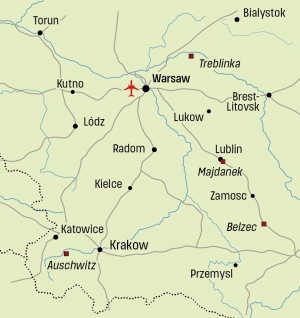
direct link
Subscribe to Our E-Newsletter
For up to date news as well as details about all of our tours please subscribe to our fortnightly e-newsletter

Quick Links
Military History and Battlefield Tours Classical History and Archaeological Tours Holocaust Tours General History Tours Experience Tours Walking Tours Future Planning Request Brochure Site Map
The Cultural Experience 11B Mansfield Park Four Marks Alton GU34 5PZ United Kingdom
UK: 0345 475 1815 USA (toll free): 877 209 5620 International: 00 44 345 475 1815
© 2015 - 2024 Midas Tours Ltd - Hosted by SWD - Legal Info - Terms of Use - Privacy Policy / Cookies - Sign-in

Sign Up Today
Start your 14 day free trial today

The History Hit Miscellany of Facts, Figures and Fascinating Finds
15 Holocaust Sites, Museums and Memorials to Visit
Explore the harrowing events and effects of the holocaust through these important sites, museums and memorials around the world..

Harry Sherrin
21 sep 2021.
Between 1942 and 1945, the Nazis embarked upon the so-called ‘Final Solution to the Jewish Question’, a systematic program of extermination. In concentration camps across Europe, 6 million Jewish people were killed – around 78% of all Jews in occupied Europe.
The Holocaust was the most widespread and industrialised act of genocide the world has ever seen.
Today, that devastating moment in modern history is remembered in sites, museums and memorials across the globe. Here are 15 of the most significant, where visitors can learn more about the history of the Holocaust.
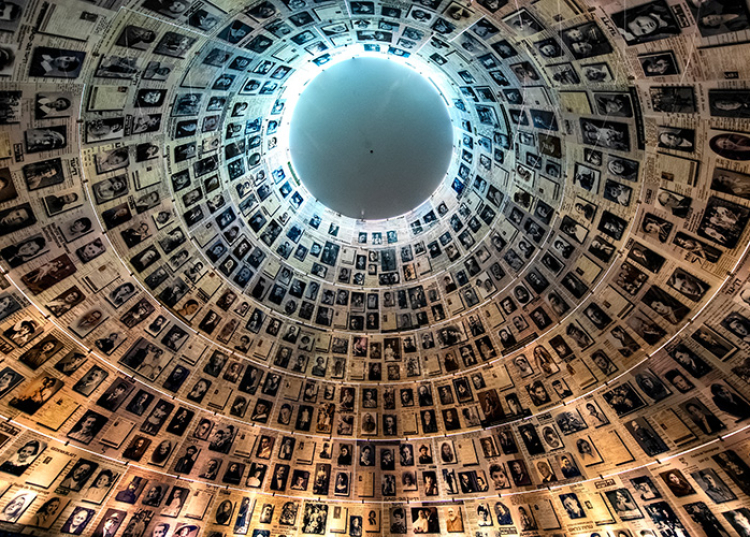
1. Yad Vashem
Yad Vashem in Jerusalem is a museum and a memorial of the Holocaust, in which over six million Jews, and at least five million from other ethnic groups, were murdered in an act of genocide perpetrated by the German National Socialist Party under Adolph Hitler .
Through exhibits including photographs, victims’ accounts, art installations and information panels, Yad Vashem offers a moving – and harrowing – account of the events of the Holocaust.
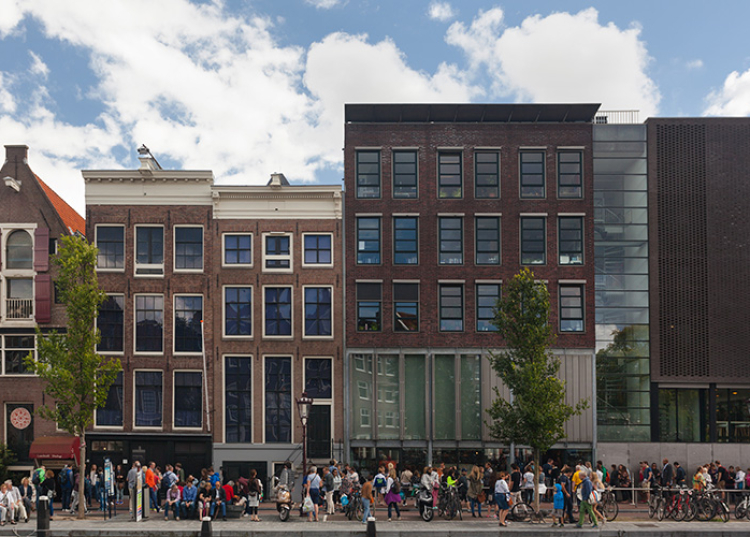
2. Anne Frank’s House
Anne Frank’s house was the site where German Jewish teenager and Holocaust victim Anne Frank , her family, the van Pels family and later a man called Fritz Pfeffer went into hiding from the Nazis during World War II. Tragically, the group’s whereabouts were betrayed to the Nazis and they were arrested and imprisoned in concentration camps. Anne Frank died in Bergen-Belsen in March 1945, but her diary was later discovered by her father and published to worldwide acclaim.
Anne Frank’s House is now a museum allowing visitors to see the moving bookcase, walk through the cramped secret annex and gain a true appreciation of the hardship this group endured in their fight for survival. The museum has collected and exhibits many original letters, photos and objects belonging to the Frank family as well as to the van Pels and Fritz Pfeffer. Anne Frank’s original diary is also on display.
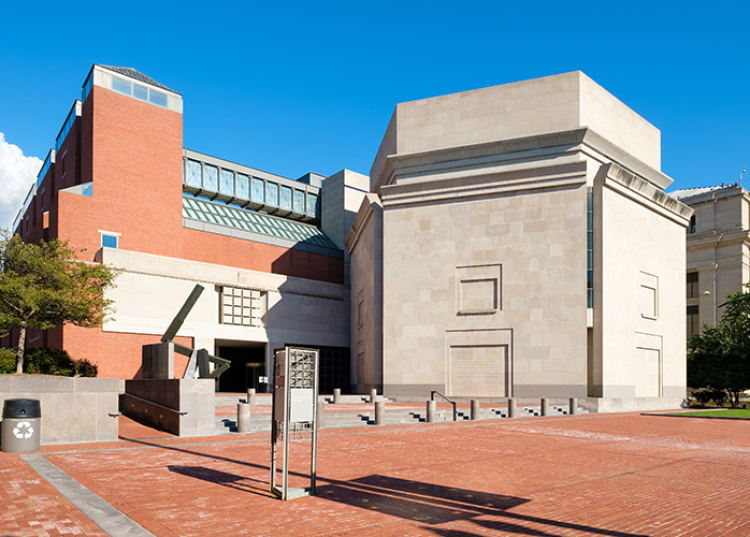
3. United States Holocaust Museum
The United States Holocaust Memorial Museum in Washington DC is dedicated to commemorating the Holocaust. Combining eyewitness testimony, displayed in films and documents, with over 900 artefacts including one of the railcars used to transport prisoners, the Holocaust Museum tells the story of this world event.
The museum also looks at the issue of genocide as a whole, displaying exhibitions about other atrocities around the world. On average, a tour of the United States Holocaust Memorial Museum takes between 2 and 3 hours.
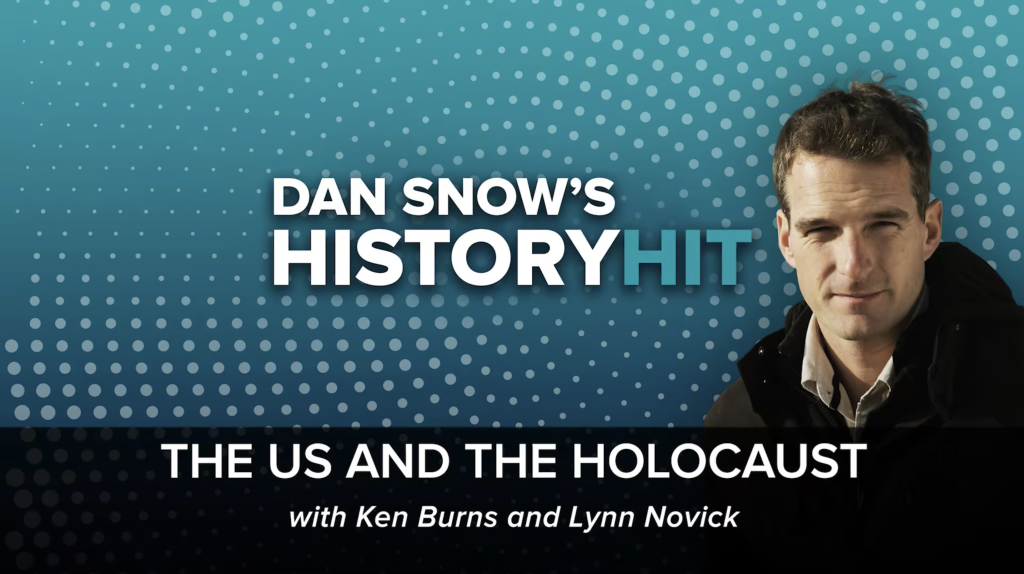
4. Auschwitz Concentration Camp
Auschwitz Birkenau was a concentration camp founded by the Nazis near the town of Oświęcim or ‘Auschwitz’ in Poland . It became the largest and most infamous camp of them all, central to Hitler’s campaign to exterminate the Jews. By the time Auschwitz was liberated by Soviet forces on 27 January 1945, the camp had claimed 1.3 million lives, the vast majority of whom were Jewish.
Auschwitz Museum is based at the original concentration camp site and offers visitors the chance to pass through the camp’s infamous arches bearing the chilling slogan of “Arbeit macht frei” or “Work will set you free”. Inside, visitors can tour Auschwitz Birkenau individually or in group tours.
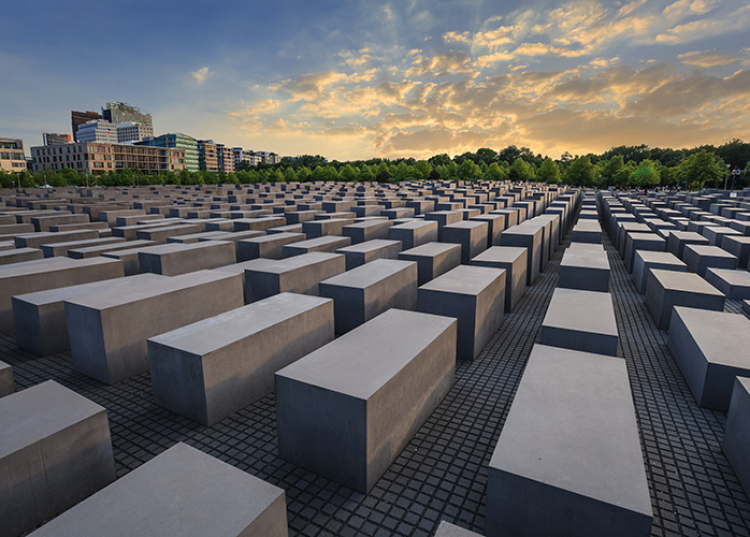
5. The Holocaust Memorial - Berlin
The Holocaust Memorial in Berlin is an installation commemorating the genocide of the Jewish people perpetrated under Adolf Hitler and the Nazis. The Memorial is a monument to the six million European Jews who died in the Holocaust.
Made up of a vast dark granite maze and a subterranean information centre which has details about the victims, the memorial is a moving site.
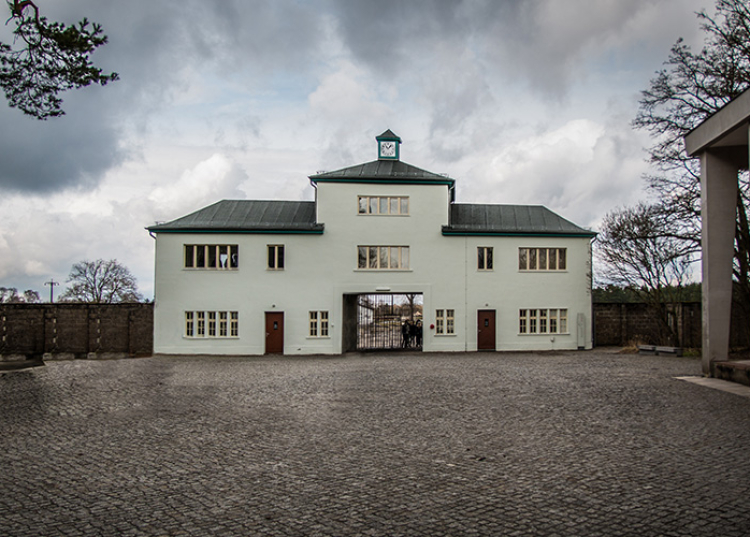
6. Sachsenhausen Concentration Camp
Sachsenhausen Concentration Camp was used by the Nazis between 1936 and 1945. Its primary function was for the imprisonment and execution – or extermination – of Jews and political dissidents, including many Dutch freedom fighters, Russian prisoners of war and even some political leaders from invaded countries.
Estimates put the number of Sachsenhausen casualties at between 30,000 and 35,000, many of whom were shot, hung or exterminated in a specially built room in its infirmary. Much of Sachsenhausen was destroyed during and after its liberation by Soviet and Polish troops on 22 April 1945, but was rebuilt as part of the project to turn it into a memorial and museum.
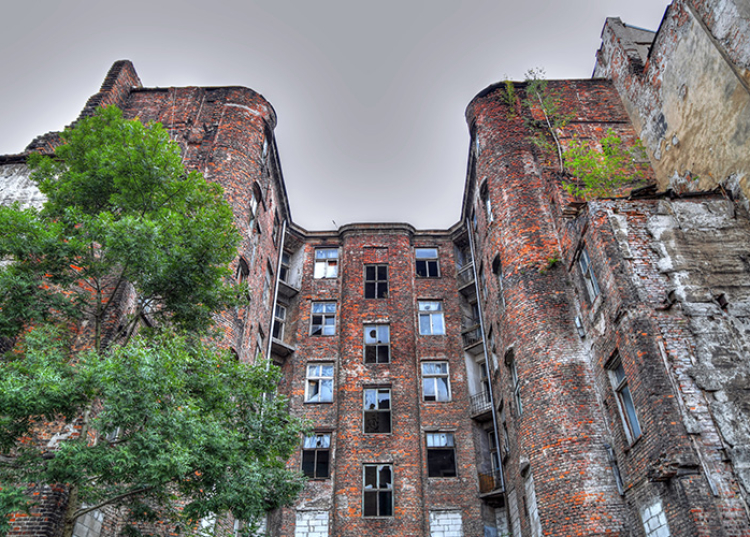
7. Warsaw Ghetto
The Warsaw Ghetto was established by the Nazis to forcibly house the city’s Jewish population, with up to 400,000 people confined here from October 1940. In 1943, the Warsaw Ghetto Uprising took place, a dramatic rebellion which occurred when the Nazis attempted to liquidate the ghetto and one which saw it razed to the ground.
Very little of the Warsaw Ghetto survives today. There are fragments of the original ghetto wall and several memorials including the Mila 18 monument where the uprising headquarters were located and an inscription where insurgent leader Mordechaj Anielewicz and the last of the uprising fighters perished. There is also the Warsaw Ghetto Fighters Monument and a monument at Umschlagplatz , the site from where Jews were transported to the death camps .
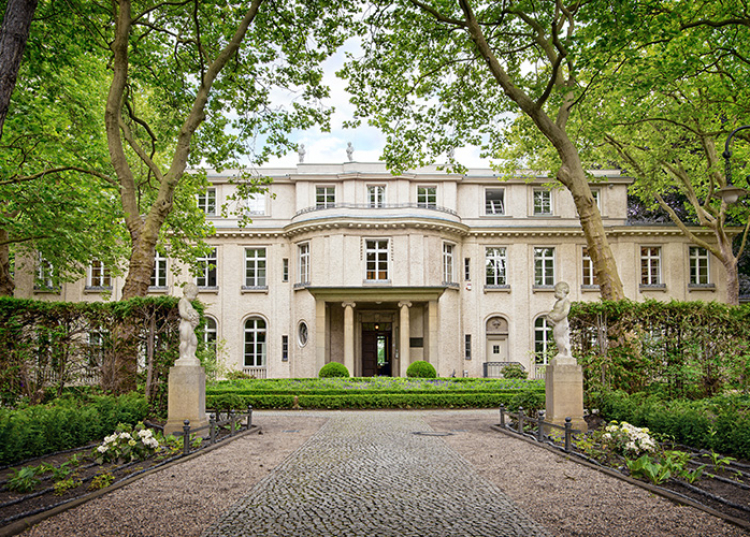
8. Haus der Wannsee-Konferenz
The Haus der Wannsee-Konferenz was the site of the infamous Wannsee Conference in which the Nazis planned how to carry out the “Final Solution”, the plan to murder the Jewish population of Eastern Europe.
Today, the site provides a moving memorial to the Holocaust as well as an in-depth history of the rise of the Nazi party, the growth of anti-Semitism and the atrocities committed against the Jews.
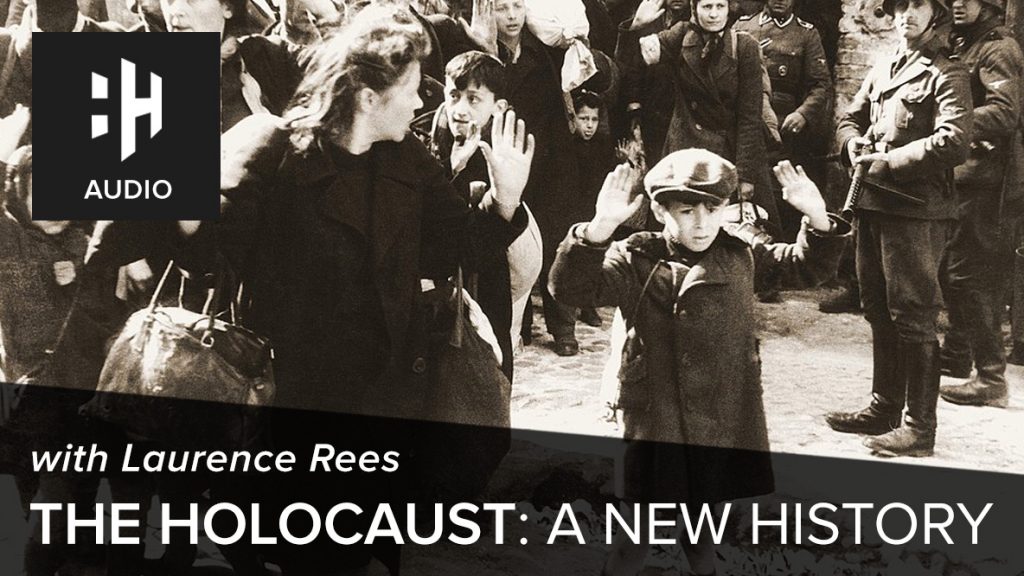
9. Dachau Concentration Camp
Dachau Concentration Camp was one of the first of many concentration camps set up by the Nazis to imprison and murder certain groups as part of their campaign of genocide.
Today, Dachau houses a memorial to those who suffered and perished under the Nazis. Visitors can tour the grounds and the remains of the camp and audio guides are available as are guided tours. There are several exhibitions detailing the history of the camp as well as a documentary shown at various times.
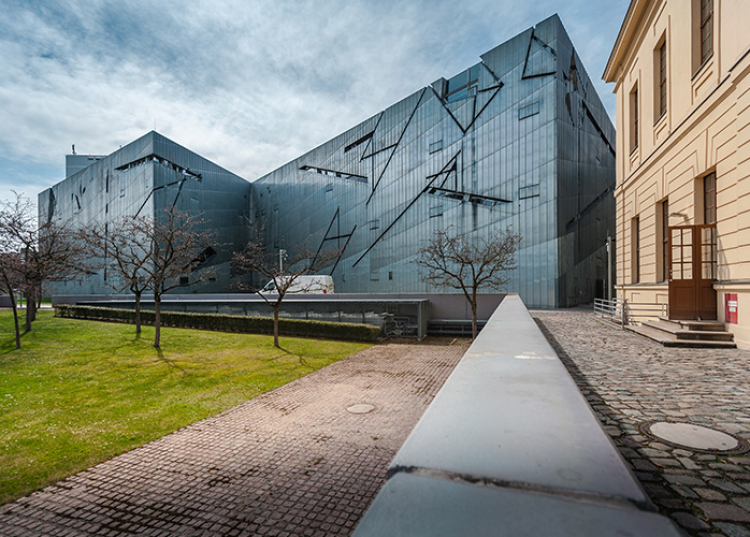
10. Jewish Museum - Berlin
The Jewish Museum in Berlin in Germany chronicles the history of German Jews over the course of two millennia. Housed in an incredibly modern building, the Berlin Jewish Museum displays historical objects, documents, photographs, multimedia presentations and even computer games relating to different periods of Jewish history and culture.
The exhibitions are arranged chronologically and cover various themes such as the living conditions of German Jews over the centuries, the role of Jewish women, tradition and change and the meaning of emancipation. The museum also looks at the issue of persecution, in particular during the Nazi era and the Holocaust, offering an insight into both the overall historical context and the lives of individual victims of the atrocities.
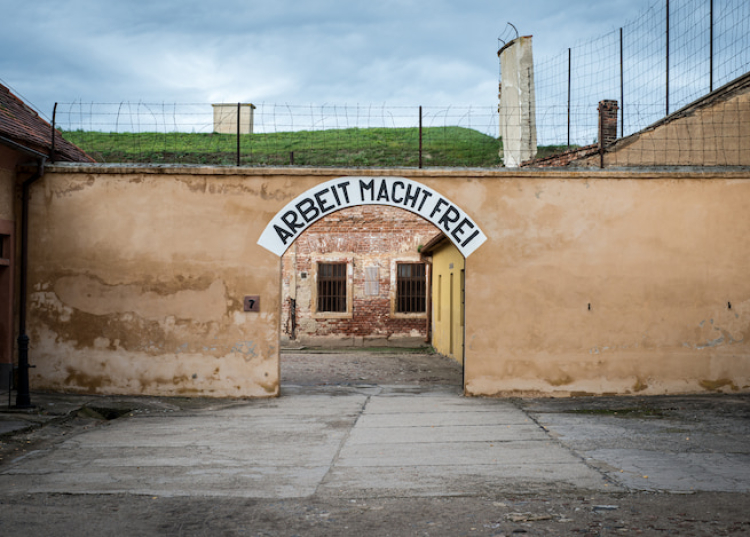
11. Theresienstadt Concentration Camp
Theresienstadt Concentration Camp in Terezin in the Czech Republic was a Nazi concentration camp during the Holocaust. Theresienstadt was originally an 18th-century stronghold known as Terezin Fortress. It was taken over during the Nazi occupation of the then Czechoslovakia in World War Two. Some 30,000 prisoners died at the camp, despite Nazi attempts to portray it as a humane institution.
Today, Theresienstadt Concentration Camp is open to the public and includes a museum as well as the possibility of visiting the former ghetto.
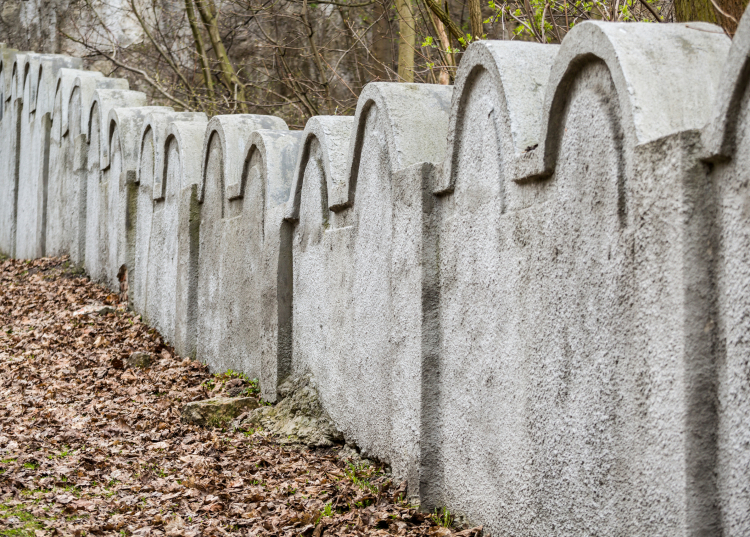
12. Krakow Ghetto Wall
Krakow Ghetto Wall is a stark reminder of the Krakow Ghetto, established by German Nazi forces in March 1941 as part of their campaign to persecute the Jews. Much of the Jewish population had already been conscripted to carry out forced labour since 1939, when the Nazis occupied Poland. In 1942, Krakow Ghetto was closed and all of its inhabitants were sent to concentration camps.
Some inhabitants of Krakow Ghetto were saved during the War by Oskar Schindler, whose famous Schindler’s List was made into a film by Hollywood director, Stephen Spielberg. Now, the Ghetto Wall, flanked by a former ghetto home, is the last remaining wall of those which once bordered Krakow Ghetto. The Ghetto Wall bears a plaque commemorating Krakow Ghetto.
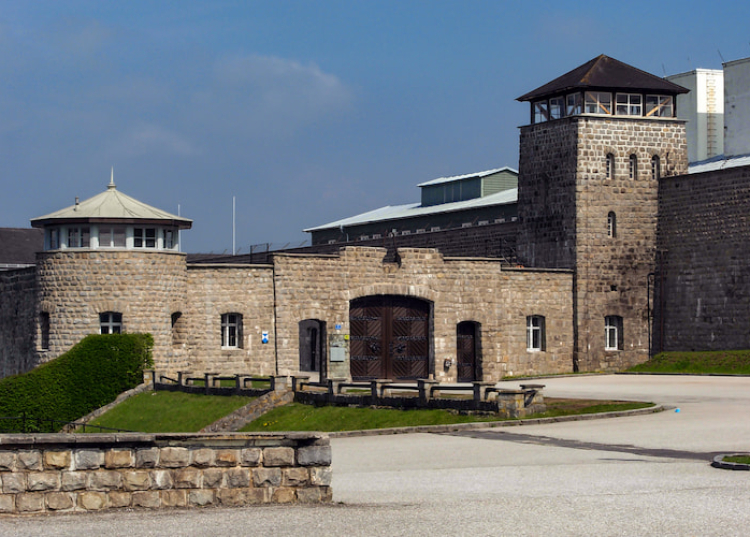
13. Mauthausen Concentration Camp
Mauthausen Concentration Camp or ’KZ Mauthausen’ was a vast Nazi concentration camp in northern Austria. First established in 1938, Mauthausen Concentration Camp was built through the slave labour of prisoners from another such camp, Dachau. Over 119,000 of the almost 200,000 prisoners at Mauthausen Concentration Camp had died there by the time it was liberated by American forces on 5 May 1945.
Today, Mauthausen Concentration Camp is open to the public, who can see the original camp and the terrible conditions to which prisoners were subjected. There is a visitor centre and many memorials to the different national, ethnic and religious groups who suffered at Mauthausen.
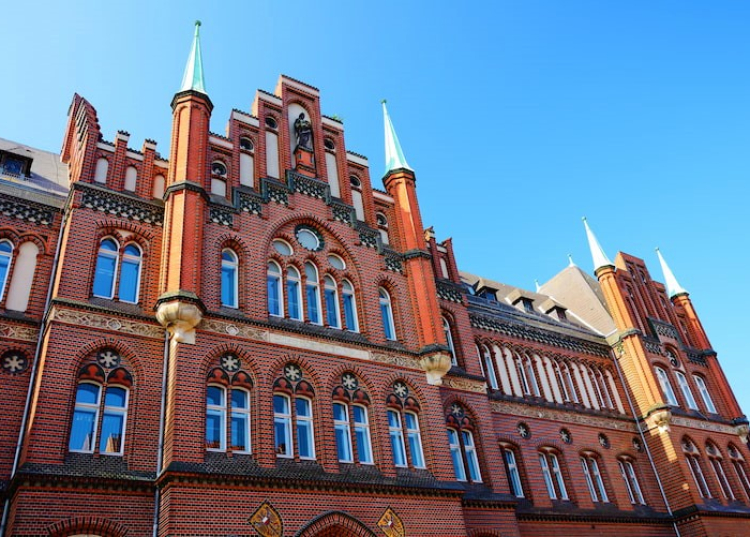
14. Burgkloster
The Burgkloster (Castle Monastery) in Lubeck is considered to be one of the most important medieval monasteries in Germany. Established in 1229, the Burgkloster served as a monastery until the Protestant Reformation, after which it was used as a poorhouse until the 19th century. Under the Third Reich, the Burgkloster was used as a Nazi prison, bearing witness to terrible atrocities, particularly against Jews and those who formed the resistance movement.
Today, the Burgkloster is a museum of Lubeck’s history. Visitors can tour the building as well as viewing exhibits on the history of Lubeck’s Jewish community and about Lubeck’s time as an important member of the Hanseatic League. This was a medieval trade block which controlled much of the North Sea and Baltic Sea.
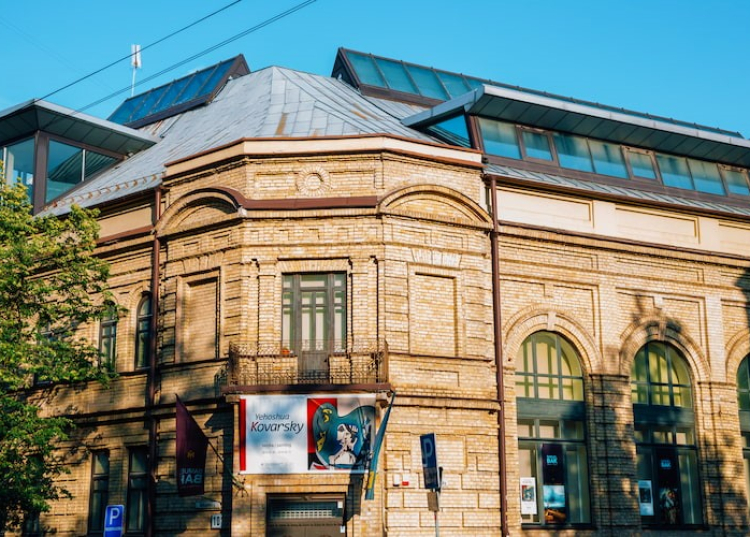
15. Tolerence Center
The Tolerence Center is one branch of the Vilna Gaon State Jewish Museum. A permanent exhibit operates at the Tolerance Center featuring the historical cultural and artistic heritage of the Litvaks, the Jewish community in Lithuania.
The displays include unique relics of the Great Synagogue of Vilnius and Jewish folk and professional art. The non-permanent exhibits, thematic events and projects are oriented toward themes including the cultural education of society, social dissemination of culture, unique cultural heritage and fundamental human rights.

Guide To The Nazi And World War II Sites In Nuremberg Germany
Planning a visit to Nuremberg Germany? Here’s my guide to visiting the historic World War II and Nazi sites in Nuremberg, for history buffs and WWII aficionados.
Despite Nuremberg’s storybook looks, the city has a dark past.No other city in Germany is more intertwined with the Nazi legacy than Nuremberg.
The Nazis went to great lengths to leave their stamp on the city, renovating the architecture and designing their massive and bombastic party rally grounds.
In Nuremberg, you can stand in the exact spot where Hitler whipped the masses into a frenzy with his faux populism and propaganda. You can step back to a horrid time in history and almost hear the crowds screaming.
It can be an intense and sobering experience. But the Nazi rally grounds are a must visit destination in Nuremberg.
This is where the Nazis succeeded in winning people over, where they staked a claim to absolute power and enshrined a cult of the Führer. This is where you’ll find the Nazi’s eerie architectural ruins and the ghosts of the Nazi monsters.
>>> Click here to book a WWII tour of Nuremberg
A Short History of Nuremberg
Nuremberg began life circa 1040. Heinrich III built a fortress on the rocky outcrop on the edge of the current city. The settlement below took its name from the fortress, Nuoin-berg (rocky outcrop) and became known as Nuremberg.
The first districts of the town were St. Sebaldus and St. Lorenz, now each boasting a towering church. The Jewish Quarter was then around Hauptplatz. The city walls were built in the 14th century.
In 1356, Emperor Charles IV decreed Nuremberg a free imperial city. Nuremberg thrived as a trade route until the 17th century.
But when it entered the Bavarian empire in 1806, the city was destitute and bankrupt. It was saved by industrialization. Henceforth, Nuremberg became “the most German of German cities.”
READ : Must See Sites and Attractions in Nuremberg
In the 20th century, Nuremberg’s dark past began. Starting in 1933, during the Third Reich, Nuremberg became the site of Nazi party rallies and parades.
Herman Goring promulgated the Nuremberg Laws, which declared that Jews were second class citizens. Only 72 of Nuremberg’s Jewish citizens escaped deportation.
During their years in power, the Nazi party worked hard to prettify and renovate Nuremberg. It became a popular tourist attraction.
On January 2, 1945, an Allied bombing attack destroyed most of Nuremberg’s old town. After the war, the city was rebuilt in its pre-war architectural style. Even though you know the charming buildings aren’t all old, they charm nonetheless.
Nuremberg quickly came to grips with its ugly Nazi past. It was in Nuremberg that the trials of Nazi war criminals were held in Courtroom 600.
Nuremberg didn’t officially become part of Bavaria until 1802. It’s actually a Franconian city and has a different vibe and dialect than southern Bavaria.
Franconians consider themselves more sophisticated than their southern counterparts in Munich , the lederhosen-clad “Barbarians of Bavaria.”
Historic Nazi And WWII Sites In Nuremberg
Let’s explore the Nazi party rally grounds and other WWII sites in Nuremberg. If you are in Munich, you get visit on a guided day tour from Munich .
1. Overview of the Nazi Party Rally Grounds
If you’re a WWII nerd or history buff in general, book a half day tour to see Nuremberg’s Third Reich sites, constructed by Hitler’s favorite architect Albert Speer.
Or, go solo and take the tram, bus, or train from Nuremberg’s central station out to the sites. Click here for information on how to get to the rally grounds. Like it or not, these sobering sites are a huge part of Nuremberg’s history.
The Nazi party rallies were carefully choreographed propaganda events used to forge and reinforce party enthusiasm. Using stagecraft, the rallies promoted the personality cult of Hitler as the “Fuhrer.” He was portrayed as a heroic and infallible god-like messiah deserving of blind obedience.
>>> Click here to book a walking tour with the rally grounds
Hitler used the party rallies to demonize his enemies, Jews and Communism. At the 1935 party rally, Hitler ordered the Reichstag to adopt the Nuremberg Laws. They revoked citizenship for all Jews and forbid Germans to marry or cavort with non-Arians.
The frenzied insanity of these Nazi rallies was captured in Leni Riefenstahl’s disturbing propaganda film, Triumph of Will . The film records the September 1934 rally in Nuremberg. In it, hundreds of thousands of Nazi party members and troops appear in zombie-like obedience to be “reviewed” by Adolf Hitler.
The rally grounds are enormous, 12 football fields in length, so be prepared to walk. The three main structures are Congress Hall, the Zeppelin Tribune, and the Great Road — all built with slave labor and meant to evoke ancient Roman architecture.
Many buildings were left incomplete when construction was suspended in 1939 by war. Others were demolished during WWII.
Though photographs from the rallies put a positive spin on these ritualistic mass gatherings, the reality was quite different. No one had thought out the logistics.
The rally grounds were an actual construction site. The rallies themselves featured trash-strewn accommodations and squalor, drunken party members, and unabashed public urination.
Since 1973, all buildings on the former Nazi party rally grounds are listed as historic monuments. In 2019, Nuremberg announced plans for conserving — not restoring — the sites on the rally grounds for educational purposes.
The plans will expand the educational Documentation Center and install information stations on the grounds. The target date for completion is 2025. Nuremberg will compete be for European Capital of Culture that year.
2. Congress Hall
Congress Hall was where the Nazis held party meetings and rallies. It was designed to seat 50,000 people.
Congress Hall is a disturbingly overbearing and banal semi-circular building, twice as large as the Colosseum in Rome Italy . At the center of the hall was a speaker’s podium for Hitler.
The structure was never completed when war intervened. So it’s an unfinished shell with no roof.
Like the Third Reich, Congress Hall was supposed to “last a thousand years.” But it’s crumbling. Nuremberg debated what to do with the historic stone pile.
Let it disintegrate or renovate it as a cautionary tale of the Nazi regime? As I mentioned above, Nuremburg chose the latter course of action and is working on preserving the site. Though it won’t recreate things that were demolished after WWII.
>>> Click here to book a private tour of the rally grounds
Address : Bayernstraße 100, 90471 Nürnberg, Germany
3. Documentation Center
Opened in 2001, the Documentation Center is in the north wing of Congress Hall. It’s a modern museum that shines a harrowing light on the insane megalomania of the Nazi party. This is the first place you should visit to get the historic background on the Nazis.
The museum is intentionally built like a spike through the colossal cement hall. The goal was to create a space that would work well as a museum, but also confront the geometrical Nazi architecture and the megalomaniacal mindset that produced it.
With unflinching eye-opening detail, the permanent exhibit Fascination and Terror describes the rise of the Nazi party and its atrocities and genocide. The audioguide is well produced and comes in multiple languages. Storyboards and photos complete the history lesson.
You’ll explore an eerie and disturbing collection of photographs, videos, audios, and models. They cover the period from WWI through the Nuremberg Trials.
It’s a gripping and emotional experience where, in the abandoned building, you can almost feel the evil.
At the end of your visit, there’s a viewing point, suspended in mid air. You can step out and, chillingly, stand where the Führer addressed the rabid masses, a little insight into the collective madness of that era.
The documentation center is open daily from 9:00 am to 6:00 pm (5:00 pm on weekends). Click here for an online ticket, which costs 6 euros. An expansion of the center just began in 2021.
Address : Bayernstraße 110, 90478 Nürnberg, Germany
4. Great Road
The Great Road is behind Congress Hall. It was intended to be the central axis of the rally grounds and a parade road for the German army.
The Great Road is 1.2 miles long and 130 feet wide, lined with white and gray granite pavers. It stretches from Congress Hall and points to Nuremberg Castle.
The road was intended to connect the Nazi ideology (Third Reich) with the medieval grandeur of imperial Nuremberg (1st Reich or Holy Roman Empire). But it was never used as intended, when war intervened. The Allies even used it as an air strip for a time.
5. Zeppelin Tribune
The Zeppelin grandstand was an open air altar for Hitler. In this fortified arena, the evil demagogue gave anti-Semitic stump speeches from his own personal rostrum. Here, pomp and circumstance hypnotized crowds and fueled a deadly ideology.
The Zeppelin is a 300 foot long tribune. There was seating for 60,000 in the rampart-like grandstands. The Zeppelin Field had a capacity of 200,000.
The Zeppelin was Albert Speer’s first completed (and only surviving) work for the Nazi party. The design was was based upon the monumental Pergamon Altar from Turkey, which is now in the Pergamon Museum in Berlin.
The name “Zeppelinfeld” or “Zeppelinwiese” refers to the fact that, in August 1909, Ferdinand Graf von Zeppelin landed one of his airplanes in this location.
At the 1934 party rally, Speer famously had the site surrounded with 150 anti-aircraft searchlights beamed straight up into the sky. This created a “Cathedral of Light,” intended to evoke a sense of mystery and grandeur.
Under the Zeppelin tribune lies Speer’s Golden Hall, the only completed Speer’s interior. The Golden Hall derives its name from its ceiling, which is adorned with glittering golden mosaics. In 1984, the hall got a restoration.
The hall was intended as a mechanism for Hitler to make a grand appearance and ascend to his spot on the rostrum. But Hitler preferred to arrive by car, walking amongst his admirers as a “man of the people.” So the hall was largely useless.
On April 22, 1945, the U.S. Army held a victory parade on the Zeppelin Field. The army blew up the gilt swastika above the center of Hitler’s rostrum.
In 1967, Nuremberg blew up the colonnades on the Zeppelin grandstand, which sparked vehement debate. The official reason for blasting the colonnades was that they had fallen into ruinous disrepair and were unstable. But the public felt the gesture was intended to sweep a terrible piece of history under the carpet.

6. Hall of Honor | Memorial Hall
The Hall of Honor was built during the Weimar Republic. It was built as a memorial honoring the soldiers killed in World War I. The hall has a rectangular arcaded hall. On each side was a row of pillars carrying fire bowls.
No matter, Hitler coopted it and incorporated it into his rally grounds. He built grandstands around it, converting the park space into the Luitpold Arena.
In the 1929 party rally, the hall was used to promote a “cult of the dead.” Hitler dedicated it to “martyrs” of his National Socialist party. He intended to attract soldiers willing to pay fealty to the Fuhrer and the Nazi party.
After 1945, Nuremberg removed the grandstands and restored the parkland. Today, Memorial Hall commemorates victims of WWI and WWII.
7. Kunstbunker
When it was obvious that Germany was losing the war and city bombings were a daily occurrence, there was a mass effort to move precious art and artifacts to safer places throughout Germany.
Art, statues, and jewels were pulled from churches, museums, and castles and stored in underground vaults, bunkers, and caves. There, they could shelter from the impact and fire associated with the large scale bombings.
Nuremberg was no exception. The Historiches Kuntsbunker , or art bunker, was one of Germany’s bomb proof shelters. The bunker was a tunnel complex under Nuremberg Castle.
In this art depot, precious objects were stored, including works by Albrecht Dürer. The shelter was almost 25 meters underground.
At the Kuntsbunker, visitors can travel down to examine the (very cold) tunnels and vaults that held the masterpieces. You can see pictures of what the bunker looked like during WWII and even see debris left behind.
Much of the bunker’s original infrastructure is still in place. It gives visitors a brief glimpse into this particular moment in history.
>>> Click here to book a ticket to the art bunker
Address : Obere Schmiedgasse 52, 90403 Nürnberg, Germany
8. Courtroom 600 in the Palace of Justice
Nuremberg wasn’t just the site of evil. It also helped bring justice to the evil doers during the Nuremberg Trials.
From November 1946 to October 1946, Courtroom 600 was where the Allies put Nazi henchmen on trial for war crimes and crimes against humanity. It was a symbolic end to Nuremberg’s Nazi ties. The courtroom is housed in the Nuremberg Palace of Justice, which survived WWII carpet bombing.
On November 24, 1945, 21 members of the Nazi leadership filed into the Palace of Justice to be tried for war crimes over four years. The most alpha defendant, Hermann Goring, claimed utter ignorance of the charges.
Hitler (along with Goebbels and Himmler) committed suicide before they could be brought to trial. Goring, the head of the Luftwaffe, took a cyanide pill the night before his scheduled execution.
The trials were publicly published so citizens could learn about the horror of the crimes and pain of the victims. After the trials, international laws prohibiting such crimes were promulgated.
On the top floor of the courthouse is a documentation center/museum, the Nuremberg Trials Memorial . It provides information about the defendants and their crimes, the subsequent Nuremberg Trials of 1946-49, and the impact of the Nuremberg Trials.
The museum traces a direct arc to the present tribunals of international justice in The Hague.
You have to purchase tickets to the Memorium Nuremberg Trials to see the infamous courtroom. But it’s worth it. There’s a lot of film footage.
You can only see the courtroom when court is not in session, generally 4 days from Friday to Monday. So plan your visit accordingly.
>>> Click here to book a Third reich tour that includes Courtroom 600
Address : Fürther Str. 110, 90429 Nürnberg
9. Dachau Concentration Camp
If you’re in Nuremberg for more than a day, you can day trip to Dachau Concentration Camp . It’s a 1:40 drive from Nuremberg. Be sure to pick up an audio guide to orient yourself. It’s a vast space.
Dachau played a significant role in having Hilter’s history in Germany. It was one of the first camps set up to hold political prisoners, subversives, Jews, and other “undesirables” during WWII.
On a visit to Dachau, you’ll be presented with the camp’s history in great detail. You’ll learn how the camp morphed from prison to murder factory. All told, over 40,000 people were murdered at Dachau and more than 200,000 people imprisoned.
There are chilling and disturbing memorials — prisoners cells, death chambers with chemical induction pipes, barbed wire fencing, and a crematorium. You can see bullet marks on the walls. The onsite museums details atrocities the prisoners suffered in this satanic world.
Dachau was liberated in 1945 by the US Army. After liberation, the camp was used by the US Army as an internment camp. It was also the site of the Dachau Trials for German war criminals, a site chosen for its symbolism.
You can book a small group tour of the memorial site or a private guided tour . You can get to Dachau on a guided day trip from Nuremberg or on a guided day trip from Munich .
Address : Alte Römerstraße 75, 85221 Dachau, Germany
That wraps up my guide to the historic Nazi, WWI, and Third Reich sites and attractions in Nuremberg. You may enjoy these other travel guides and resources for Germany:
- 1 Day Itinerary for Munich
- 4 Day Itinerary for Munich
- 10 Day Itinerary for Bavaria
- Most Beautiful Towns in Germany
- Guide To Castles in Bavaria
- Guide to Rothenburg ob der Tauber
- Guide To Regensburg
- Things to do in Bamburg
If you’d like to visit the historic WWII and Nazi sites in Nuremberg, pin it for later.
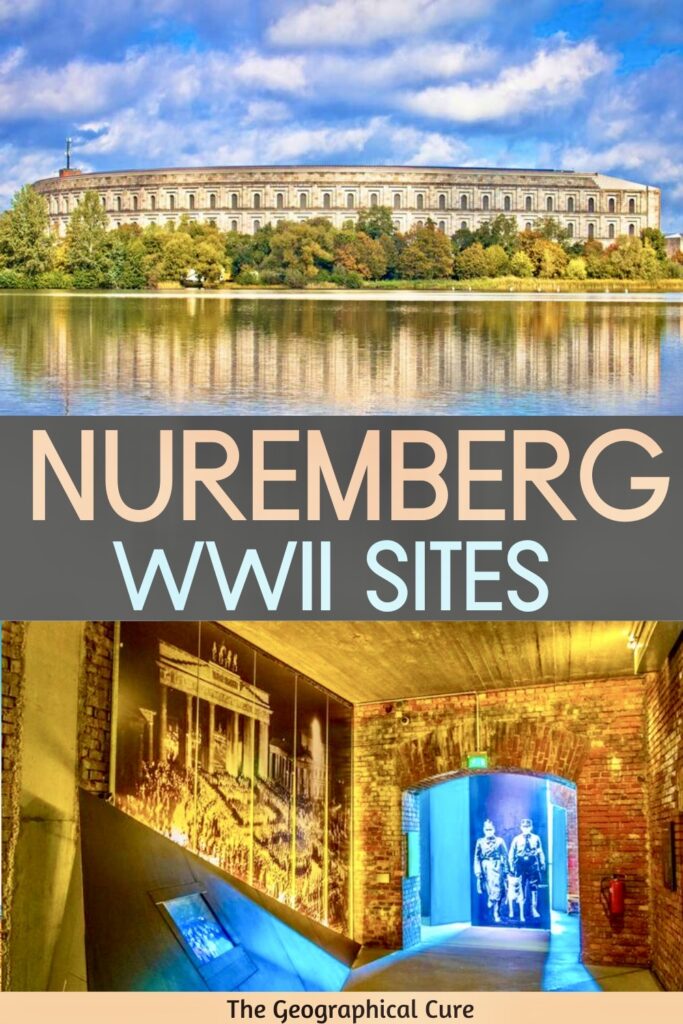
2 thoughts on “Guide To The Nazi And World War II Sites In Nuremberg Germany”
Wow, this is great Leslie. It’s exactly what I was looking for, being indeed a history buff. I’m going to Munich in the summer of this year and I wanted to visit Nuremberg from there. This guide is exactly what I need to go there for a day (or perhaps two days). I already found your travel blog this year when I went to Rome. That was an interesting guide too. I’m going back there in June, and probably will go back there for short holidays many more years (culture, good food and sunshine: nothing else to wish for). I live in Amsterdam and I’ve seen a lot of the world (I used to travel alone for many months, specially through Asia. No problems there for a women). Now I’m more interested in places in Europe. So, thank you for this site. I’m sure I will go to a lot of the places you described.
You’re welcome Lieke! Enjoy Munich. I do have a 1 day in Munich itinerary and a 4 days in Munich itinerary. Lucky you being based in Amsterdam. Makes it so easy to see Europe.
Leave a Comment Cancel reply
Save my name, email, and website in this browser for the next time I comment.
Last Updated on July 6, 2023 by Leslie Livingston
- All Destinations
- United States
- European Theater
- Pacific Theater
- The Home Front
- The Holocaust
- Pearl Harbor
- WWII Events
- Wings, Wheels, & Weapons
- General WWII Travel Topics
- Work With Me
- Skip to main content
- Skip to primary sidebar
DESTINATION: WWII
A World War II Travel Blog

Complete Guide to Visiting Dachau Concentration Camp Outside Munich
Last Updated: April 22, 2024 // by Ashley Smith 52 Comments
Before my first trip to Germany, a friend told me to visit Dachau Concentration Camp and that the experience would change my life. Wait just a minute… can you visit Dachau? Yes, you most certainly can.
The former concentration camp has since been turned into a memorial site. It opened to the public in 1965 and welcomes around 800,000 visitors each year.
And while visiting a concentration camp was completely off my tourist radar at the time, I took him up on his suggestion. My first time visiting Dachau Concentration Camp was back in 2012 and my friend’s prediction proved true. The experience changed me. Seven years later it did so again.
Table of Contents
Is it worth visiting Dachau Concentration Camp?
Absolutely. 100%. You can’t understand suffering, fear, perseverance, and you really can’t understand the Holocaust until you’ve visited a concentration camp.
The experience is unlike even your wildest imagination and it’s so much bigger than you’ve ever imagined. It’s not necessarily a pleasant way to spend a day on vacation, but it’s definitely a worthwhile and important one. If you’re looking for a no-holds-barred WWII learning experience, this is about as raw as you can get.
Because seven years had passed, I spent some time visiting Dachau Concentration Camp again in September 2019 to refresh my memory. It turns out I’d remembered everything from my first visit, word for word, image for image.
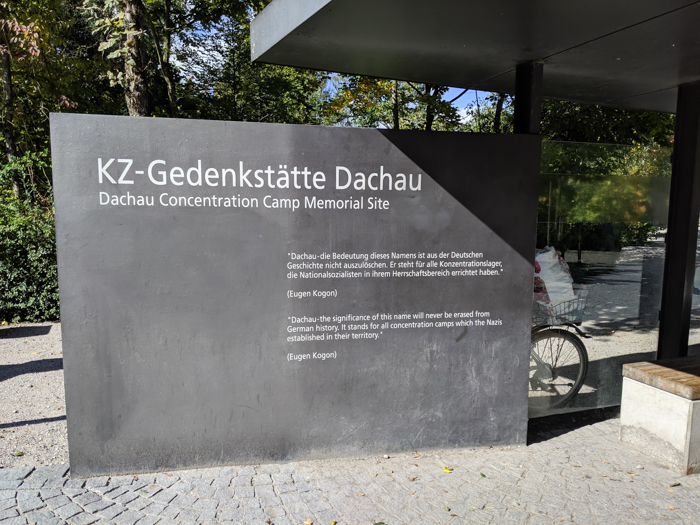
You can find my full guide the World War II sites of Munich in this link.
About Dachau Concentration Camp: some facts
Dachau Concentration Camp began operation on March 22, 1933 in the town of Dachau, about 10 miles northwest of Munich, Germany (the birthplace of the Nazi party ).
It began as a camp strictly for political prisoners—social democrats, communists, other Nazi political opponents and the like—and held 4,800 prisoners when it opened.
As we know, Dachau expanded in both size and requirements to holding other groups like Roma, homosexuals, Jehovah’s Witnesses, and in the days following the Kristallnacht of November 9-10, 1938, 10,000 Jewish men. It’s estimated that during its existence, 41,500 people died at Dachau Concentration Camp. However, the exact number will never be known.
Dachau Concentration Camp was the first ever Nazi concentration camp in what would become a total of 44,000 camps and similar incarceration centers.
It was used as a Nazi training facility for SS camp guards. Because of its “success,” was used as a model for all concentration camps built afterwards. American troops liberated the camp on April 29 th , 1945. It was the only concentration camp in operation for the entirety of the Third Reich.

Looking for another great day trip from Munich? Don’t miss the Eagle’s Nest in Berchtesgaden . (I recommend skipping the bus though and doing the Eagle’s Nest hike instead!)
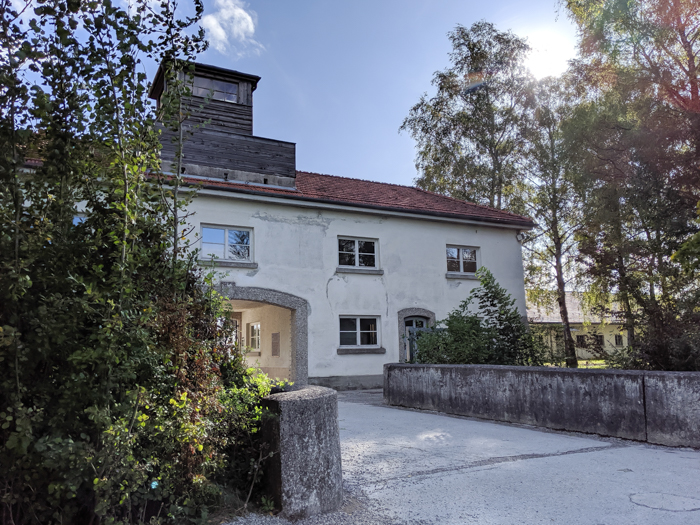
Also check out: Visiting Ljubelj Concentration Camp in Slovenia/Austria
How to get to Dachau Concentration Camp
Located just 10 miles from Munich, visiting Dachau Concentration Camp is both quick and easy via public transportation.
I mean, if you can drive a stick and haven’t experienced the German Autobahn yet, driving there wouldn’t be the *worst* thing. But I can’t drive a stick and after enough trips on it the Autobahn terrifies me so I’ll just stick with the train, mmmkay?
Visiting Dachau Concentration Camp via public transportation
From my hotel near the Hauptbahnhof to the entrance of the Dachau memorial site, it took me exactly one hour of travel time. That’s from a combined walk + buy transportation tickets + train + bus.
From wherever you are in Munich, it’s really the easiest to just start your journey at the Hauptbahnhof, Munich’s main train station (because your Munich hotel probably isn’t too far away).
Inside the Hauptbahnhof, rather than trying to figure out your routes and times and what-not, simply purchase a single person day ticket called “ Munich XXL .” This ticket covers all transportation on both the trains and the buses you’ll need for your day visiting Dachau Concentration Camp and covers you for an entire day.
Important note: The Munich XXL ticket covers you for your entire day, but not for a 24-hour period. Regardless of what time you buy the ticket, it will expire at 6:00 am the next morning.
After purchasing your train + bus ticket inside the Hauptbahnhof, head straight past the regional trains and pretzel vendors, downstairs to the S-Bahn trains.
Taking the train to Dachau Concentration Camp
Here you’ll want to take the S2 train in the direction of Petershausen/Dachau/Altomünster. I realize it looks obvious with the word Dachau in there, but the trains could say all three, or just one. On my most recent visit, my S2 train simply said “Altomünster.”
If you’ve never taken the S-Bahn in Munich, you’re in for a treat. The signs at the stations and the signs at the platforms keep you well informed as to where you need to be and how long until the next train arrives.
On board, screens will show the order of the stops and which stop is next. Provided you’re not lulled to sleep at some point, it would be almost impossible to miss the stop for Dachau.
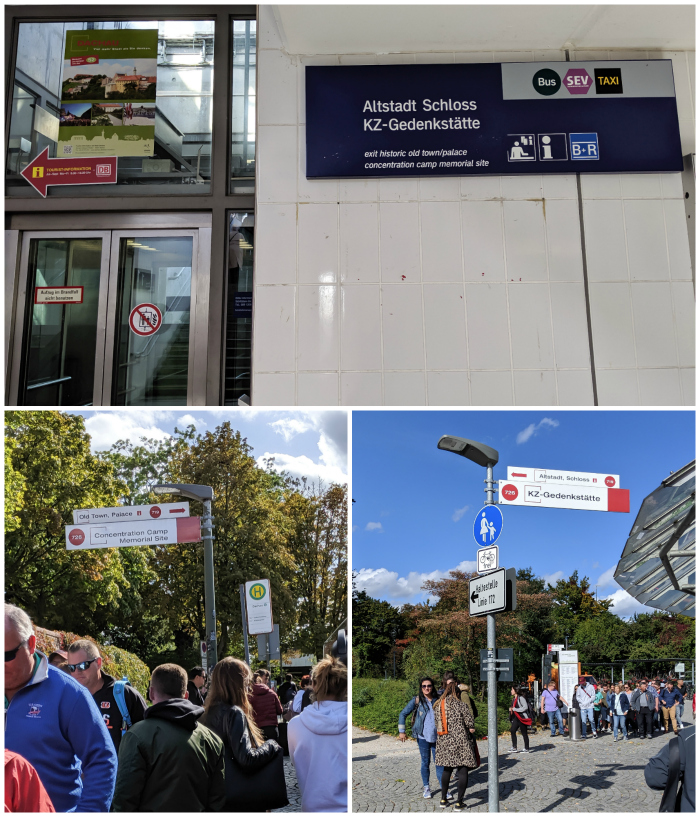
While in Munich, be sure to check out some of the many museums and memorials dedicated to the White Rose resistance movement .
Catching the bus to Dachau Concentration Camp
At the Dachau train station, head downstairs from the train platform and follow the signs for “KZ-Gedenkstätte.” This is how locals refer to Dachau Concentration Camp.
These signs will lead you outside and to a curb-side bus stop where you’ll board bus 726 in the direction of “Saubachsiedlung” (which operates as bus 744 on Saturdays, Sundays, and official holidays, for whatever reason).
Pro tip: When in doubt, which is a lot, I always double check with the driver to make sure the bus I’m getting on is the one I need to be on. And when you’re headed to such a popular tourist site as this one, even if the driver can’t speak your language, chances are he/she will still know what you’re talking about.
The bus will stop immediately outside the entrance to the Dachau Concentration Camp Memorial Site. Getting back to Munich is simply the reverse of this: Grab the 726 (or 744) bus going the other direction (i.e., on the other side of the street) towards “Dachau Bahnhof,” then at Dachau train station, take the S2 towards “Erding” and get off at the Hauptbahnhof (or whichever stop is closest to your hotel).
Visiting Dachau Concentration Camp via car
Plug this address: 73 Alte Römerstraße (the dedicated parking lot for visiting Dachau Concentration Camp) into your GPS. Follow the instructions. There you go.
Parking at Dachau Concentration Camp is 3 euros per car and they only accept cash for this.
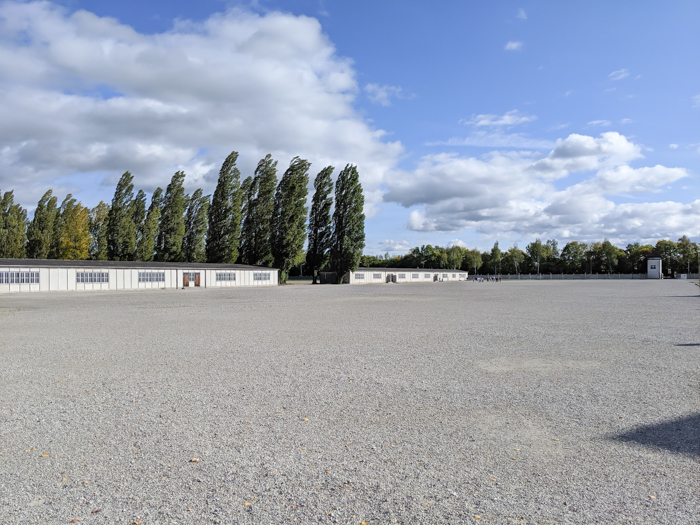
Read also: Visiting Terezín Concentration Camp from Prague : How to Get There, What To See, Tips, and More. (This is the camp commonly known as Theresienstadt.)
What to see when visiting Dachau Concentration Camp
Technically speaking, when visiting Dachau Concentration Camp you can expect a large number of explorable sites spread out around an unbelievably huge piece of property. Among them you can see:
Visitors’ Center
Here you can pick up audio guides and meet with tour groups, check out the gift shop, use the restroom, and have a snack or a bigger lunch.
Many original buildings and sites
- The camp’s main gate (the Jourhaus)
- a number of original watchtowers around the camp
- Original detention bunkers that were built to isolate, torture, and murder rebellious prisoners (among them, Georg Elser, the German carpenter who attempted to assassinate Adolf Hitler in 1939)
- The camp’s original crematorium – The building also includes access to the fumigation cubicles and the gas chamber. There is also a walking trail behind the building where you’ll find mass graves and an execution range.
The memorial site’s permanent exhibition
This is a large museum-type exhibition focusing on the prisoners’ arrivals at Dachau, their lives inside the camp, and finally their journey to either death or freedom.
They consider this exhibition the bread and butter of visiting Dachau Concentration Camp. This part will take about an hour in itself.
Documentary film
Inside this exhibition you’ll have the option of watching the short documentary film, “The Dachau Concentration Camp 1933-1945” (1969) I highly recommend it, but consider yourself warned. Bring tissues, not toddlers.
Recreated prisoner barracks
The originals were destroyed after liberation but this one has been rebuilt to original specs so you can get a feel for the prisoners’ living space.
A center walking path lined with trees
This is known as Camp Road. The original trees were planted by the prisoners in 1937 but were later removed and replaced with the ones you see today.
Four religious memorials + a convent
Jewish memorial, The Mortal Agony of Christ Chapel, Protestant Church of Reconciliation, Russian-Orthodox Memorial Chapel, and the Carmelite Convent
And an enormous, wide open property that’s bigger than you can imagine. You’ll also find informational placards placed all around the site which makes a free, self-guided tour easily possible.
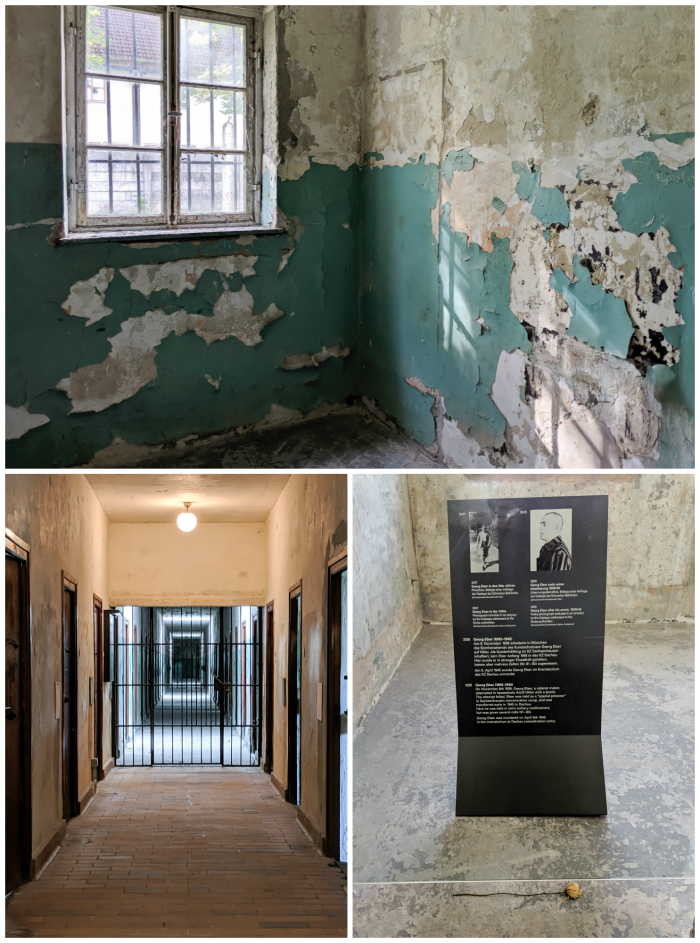
Related : Check out what else there is to see and do in Munich in this post.
What to expect when visiting Dachau Concentration Camp
Not technically speaking, while visiting Dachau Concentration Camp you can expect:
A thorough, in-depth sea of information
Like, an unreal amount of information concerning all topics related to Dachau Concentration Camp. It may take you seven years to process it.
A somber environment, obviously
The Dachau Concentration Camp Memorial Site is just that—a memorial site dedicated to the men, women, and children who suffered and died there. It’s not a “tourist attraction.” Because of this, the site has a totally understandable list of guidelines for visitors .
A lot of walking
The former concentration camp is enormous so be prepared to rack up those steps. Also, the majority of the property is covered in gravel so wear comfortable/appropriate footwear.
Exposure to the elements
Also, because most of your tour will take place outside, be sure to dress according to weather conditions—rain coats and umbrellas, sunglasses and sunscreen in the summer, warm outerwear in the winter, etc.
Most importantly
To look at life completely differently after your day visiting Dachau Concentration Camp.

Also check out: How to Visit Birkenkopf Stuttgart (Germany) for the unique perspective at WWII’s Rubble Hill
Guided tour or audio guide?
Visiting Dachau Concentration Camp for the first time, I went with one of the amazing guided tours. And if this will be your first time, that’s what I’d recommend.
Dachau guided tours
English-speaking guided tours are offered every day at 11:00 am and 1:00 pm, last about 2.5 hours, and cost just 4 euros (about the same in U.S. dollars).
They cover the main areas of the site—the former camp grounds, the historical buildings, and some of the permanent exhibition—in order to provide a well-rounded overview of Dachau.
However, you’re still free to roam about the property as you wish both before and after your tour. Don’t worry that you’ll be limited if the tour leaves anything out.
They sell tickets for guided tours on a first come-first served basis at the information desk in the visitors’ center, limit them to 30 people, and they do sell out so try to arrive early.
Dachau audio guide
On the other hand, on my latest visit to Dachau Concentration Camp I opted for the audio guide and it did not disappoint. (Well, I mean I was , but for much different reasons.)
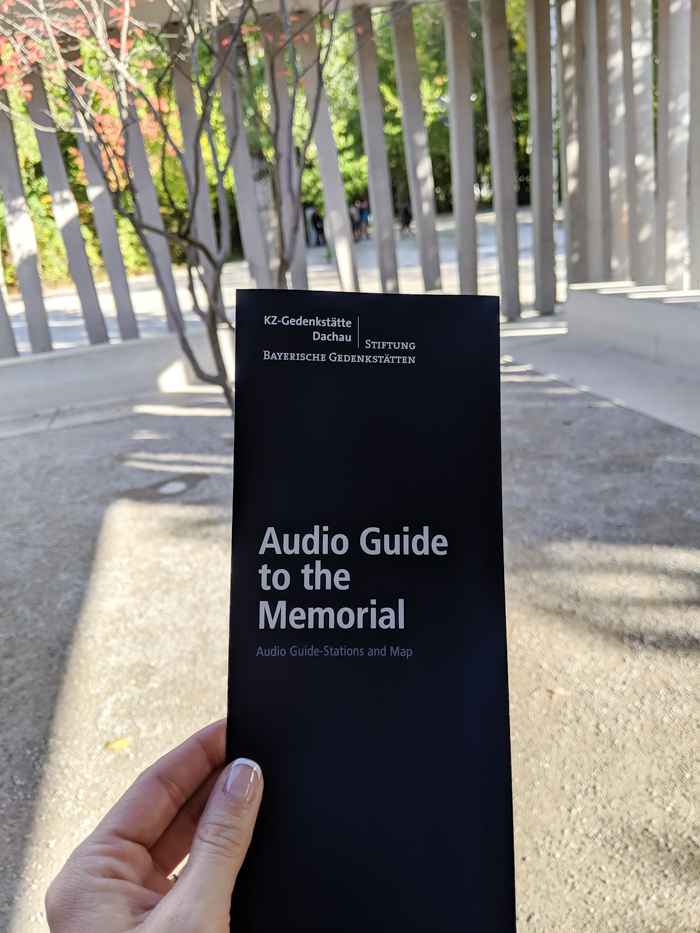
The audio guides provide information in 14 languages—English among them—and come with a map you can easily follow along with. They’re comfortable to wear and easy to use, and allow you to pause if you’d like to continue exploring an area, stop to take photos, do some Googling, whatever. You will not feel bound to a group and you don’t have to follow any certain order.
Renting an audio guide
Rental of an audio guide costs just 4.5 euros but requires a deposit. For this you can leave either your ID with the person at the front desk or some money. I say “some money” because I feel like their deposit policy is super open to interpretation.
Audio guide deposit
I didn’t feel comfortable leaving my ID as a deposit since I only had my passport with me at the time. I was told, after several minutes of digging through my purse to see what else I could leave them, that I could leave 10 euros instead .
That I had and that I was not afraid to never see again because I could indeed get back home without it. However, upon returning my audio guide to the desk later, I witnessed another solo female traveler in the same predicament.
Only after she expressed not wanting to leave her passport was she given the option to leave 20 euros as a deposit instead. Obviously this money is returned to you when you return the audio guide so the amount is negligible, but still, something to keep in mind.
So which one is best?
The information you’ll learn through the audio guide is not much different from the guided tour. In fact, I remember some of the information on the audio guide word-for-word from my guided tour. However, with the guided tour you have the added benefit of being able to hound your tour guide with questions.
In other words, you won’t be disappointed (in a manner of speaking) if you decide on one kind of tour over the other.
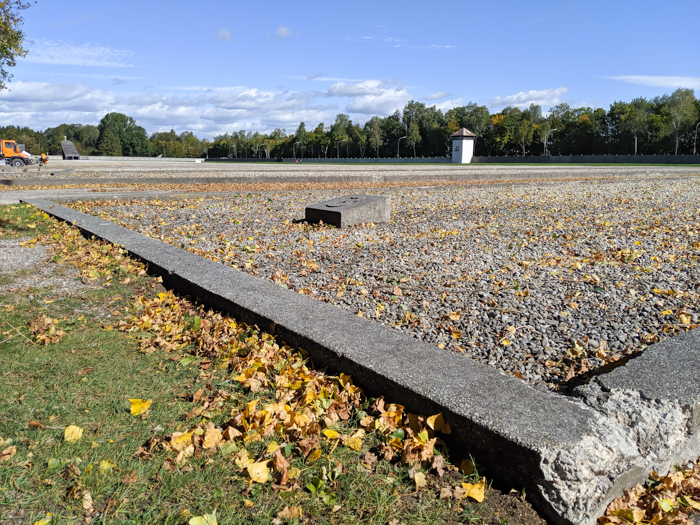
But there is a third option! If you’ve left all your IDs and all your euros at your hotel, visiting Dachau Concentration Camp is still possible.
The memorial site is completely free to visit and the abundance of written information around the site will still teach you what you need to know. You can still view the documentary film, tour the permanent exhibition, shop in the gift shop, and explore all of the sites of the former camp.
Pro tip: Download the official Dachau Concentration Camp Memorial Site mobile app before your visit. It offers logistical tips and information, background information on Dachau, summaries of the exhibitions, photos, and more. The app is available for free both on Google Play and the Apple app store .
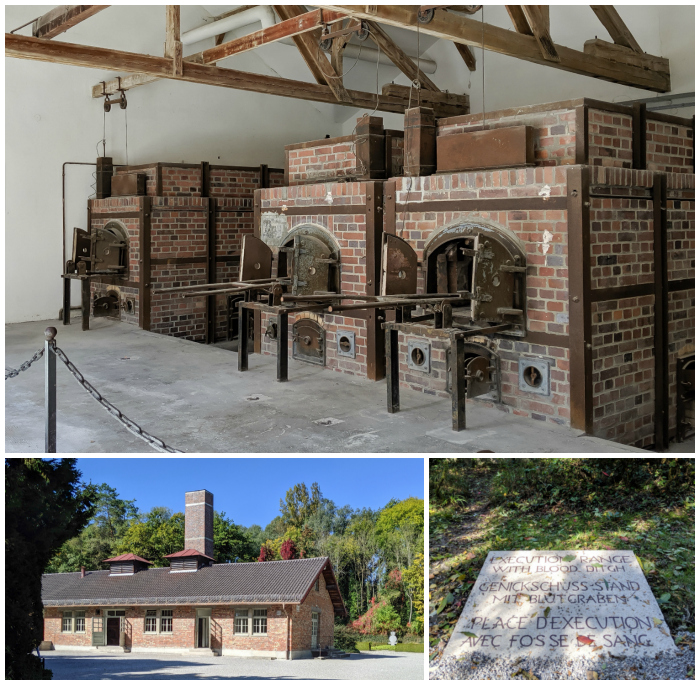
Things to know before visiting Dachau Concentration Camp
They don’t sugarcoat anything..
The first thing you should know before visiting Dachau Concentration Camp: they don’t sugarcoat anything. They don’t hold anything back and they don’t hide from their horrible past.
All of the ugly facts and photos are put out there for you to see and nothing here is subtle. If you’re expecting a discreet retelling of historical events, forget about it.
On my way back to Munich, an Australian visitor on the bus asked what I thought of Dachau. He followed up by telling me he didn’t agree with them allowing visitors into the crematorium. But why not? Hiding the hideousness of the past doesn’t do anyone any favors. (Well, except the Nazis.)
In fact, the former concentration camp that is now the Memorial Site was established “on the initiative of and in accordance with the plans of the surviving prisoners” who joined together to form the Comité International de Dachau (the International Dachau Committee) before the camp was even liberated.
It’s because of this committee and its members that the demolition of the former crematorium was halted in 1955. And it’s because of them that the former camp became an official memorial site in 1965. Opening the crematorium to visitors, for instance, is not exploitation.
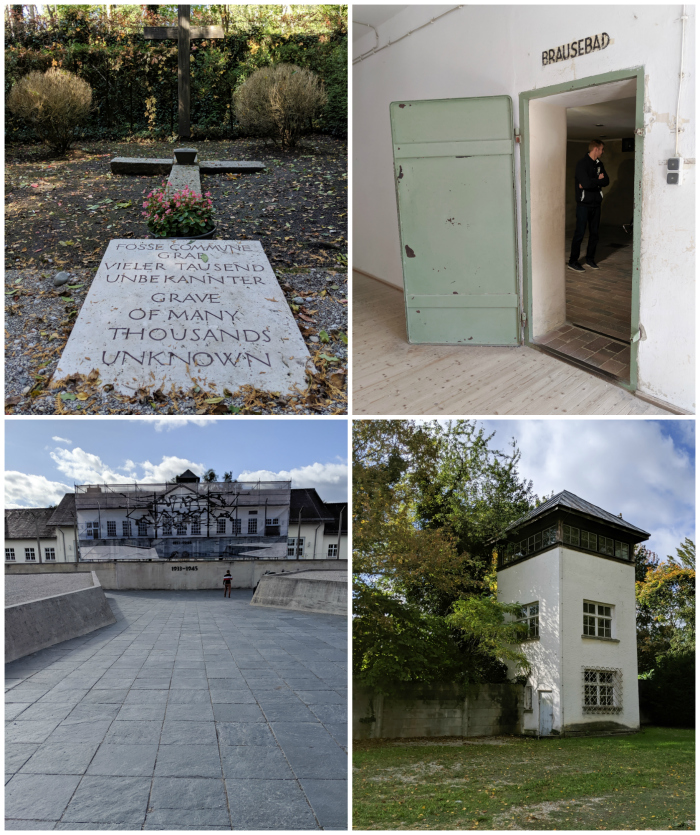
How long will a visit to Dachau Concentration Camp take?
Expect visiting Dachau Concentration Camp to take you around 4 hours . There is a lot to see here and it’s not the kind of place you can rush through, especially given its size. Plan for a half day (plus an hour to get there and an hour to get back to Munich).
Is there a place to eat lunch?
And since you’ll be here for so long, make sure to plan for lunch in the site’s cafeteria . They have a small but adequate cafeteria offering snacks, a variety of hot meals, coffee, sandwiches, and much more with plenty of seating and reasonable prices.
How to dress for your visit
Again, while here you’ll spend most of your day outside so dress according to the weather .
On visiting Dachau Concentration Camp with children
I personally don’t have any children, so I’ll just relay some information. The Memorial Site warns that some of the content may not be appropriate for children under the age of 13 but it’s at the parents’ discretion whether they bring their kids or not.
Children can visit when accompanied by their parents however they restrict guided tours to visitors ages 13 and up and the documentary film inside the permanent exhibition has a minimum age requirement of 14.
For more on this topic, see my post on visiting concentration camps with kids and what you need to know.
Visiting Dachau Concentration Camp: necessary info
Dachau hours.
As of this posting, Dachau Concentration Camp is open 364 days a year from 9:00 am to 5:00 pm. It’s open every day of the week and closed only on December 24th.
Dachau admission
Visiting Dachau Concentration Camp is free. There is no entrance admission but guided tours and the use of audio guides will cost you just a few euros. However, it is possible to visit the site without taking any kind of tour if that’s all your schedule allows.
Here’s hoping you have a terrible day visiting Dachau Concentration Camp. (That means you learned a lot!)

More resources for visiting Dachau Concentration Camp
- Hotels: Find great places to stay in Munich here on Booking.com (but Hotels.com and Expedia are also worth checking)
- Rental cars : Check out the best local rental car deals here.
- Travel planning: Don’t forget a Germany guidebook and this Germany customs and culture guide
- Local tours : See all the great options from Viator and Get Your Guide here.
Like this post? Have questions about visiting Dachau? Let me know in the comments below!

Save this info, pin these images:

Subscribe to DWWII
About Ashley Smith
Ashley is a World War II historian and travel expert who has visited 33 countries. She specializes in quick trips throughout Europe and the Americas with a focus on World War II museums, memorials, battlefields, and other sites of interest. Originally from Memphis, TN, she currently lives in Boston with her husband and two feline commanders.

Reader Interactions
November 26, 2019 at 5:38 pm
Ashley, Reading this guide brought back so many memories from when my wife and I visited Dachau two years ago. I think the best word to describe our experience would be “sobering”. There was one thing that annoyed me, and that was the clueless people taking selfies at the camp with apparently no regard to what took place there. We even saw someone close the main gate to pose in front of it……………………..
November 26, 2019 at 6:36 pm
Yes, “sobering” is an accurate word for sure. And yes, I’ve seen that a lot of places. Luckily I didn’t see anything like that happening there on my latest visit (Oct 2019), so hopefully people are figuring out what NOT to do at places like this. Hopefully by the end of their visit they learned a thing or two.
December 14, 2019 at 3:56 am
I visited Dachau with my husband and 3 month old in April 1977. We were stationed up in Wurzburg, and had come to Munich to register our son’s birth at the American Councilate (sp). We had planned to see the Olympic Stadium but got on the wrong road and ended up at the camp. It was a visit I shall never forget. Reading your comments brought back a lot of memories of walking through the grounds, seeing the photos on the walls, the memorials, the ovens. I remember walking out the back of the room with the ovens and saw a beautiful stone menorah. I remember one area where we crossed over a river. My husband told me the river was filled with blood during the war. I’ve never been able to find any info on that. Seeing the camp was very emotional for me, but I am glad we went. A memory I will forever hold onto of a human tragedy that must never happen again.
December 14, 2019 at 2:06 pm
That’s such an interesting story! How you meant to go somewhere else and ended up at Dachau – like it was meant to be. It’s one of the most sobering experiences out there for sure. And as you’ll see, not much has changed since 1977. The stone menorah is still there, and you still get to walk over the river. Thanks for your comments Deborah!
October 28, 2020 at 5:58 pm
Thank you for the well done article on Dachau. It brought back many memories. I was Stationed in Augsburg, 50 years ago. Dachau was about halfway from Augsburg to Munich and the shortest way was to drive through Dachau. Also, back then there were no cell phones (of course) and no direct dial calls, so all calls had to go through the switchboard which was in Dachau and the Operator would say “Dachau, dial your number” which always gave me creeps. Finally, the military prison was in Dachau . I took my wife and kids to Europe in 1992 and we all went to Dachau, as one of the posts said, a sobering experience for all. This was my third trip to Dachau, I went twice in 1965-66, once before the memorial and once after, and my recollection was the more sobering experience was before the memorial.
I hope the German people will always keep memorial open.
Thanks again for the post
October 29, 2020 at 11:05 am
Thank you for your comment and your story, Don! I agree, I hope the memorial stays open forever and that everyone gets a chance to experience it.
May 30, 2021 at 5:07 pm
Just wanted to say thank you for this post/blog. My friend and I are visiting Dachau tomorrow and it will be for both of us our first concentration camp. You said it best, hope to have a good day which means learn a lot. Thanks again.
May 31, 2021 at 9:54 am
You’re absolutely welcome Alexander! I hope you get a lot out of your visit.
February 28, 2021 at 10:16 pm
I remember the KZ shortly after the war. Then many years later again but I was retired. I was rather sad that the place looked more like a city park. Many of the items such as the dog cage’s, hanging tree. blood trench were missing. the ovens have been cleaned out and the grey metal shower heads had been removed and I believe the ceiling of the gas kammer has been covered over. I feel it takes away from the horror the those who lived through that there and those who did not come back out the main gate. A well kept clean park. It would give people a real sense to smell and see the way it really was.
March 1, 2021 at 10:17 am
Wow, I bet it was much different so soon after the war. I haven’t seen some of the places you mentioned but I did find the shooting range and blood trench back behind the crematoria though it’s in a wooded trail. I agree that sites like these shouldn’t remove their worst parts, but I do think they’re still able to paint the same images for visitors.
March 6, 2021 at 1:54 am
I’ve been to Dachau just once – with my husband in 1970. Hard to believe that was just 25 years after Dachau was liberated and the war ended. We had a different experience than those described here. We had purchased a VW Bug in the US, which we then picked up in Germany to begin our 3 week vacation traveling with Frommer’s Europe on $5 A Day. Yes, we were young and poor and actually followed it! We thought we had allowed enough time to get to Dachau and see everything, but we got lost and could NOT find it! My husband was fluent in German, but when we would stop and ask local people along the way where the camp was, they would all just shrug and shake their head, “No,” as if they had no idea what he was talking about. There were absolutely NO road signs to the camp. It was as if no one wanted visitors going there. We lost a good two hours just trying to locate it. Finally we stumbled onto it, with maybe 20 minutes till closing. The museum had already closed. But I remember the general layout and most especially the memorial with the twisted metal “bodies” sculpture. They also had “Never Again” in 5 languages as part of the memorial. I have one photo of that. I’ve been back to Germany 3 or 4 times since 1970, but I never went back to Dachau. However, a few years ago I visited Israel and The Holocaust History Museum. It is stunning!! Huge, complete, and heart breaking! I definitely recommend that if you’re in Jerusalem. So my experience at Dachau is a little different from yours, but still extremely meaningful, especially when combined with other related experiences in my life over the last 51 years . . .
March 7, 2021 at 8:47 am
Thanks for sharing Joan! What an interesting experience! I will definitely remember your suggestion for Israel.
December 27, 2021 at 5:38 am
This is so well written and explained article. Thanks a ton. Absolutely no gap left in covering all the aspects of the trip. Simply brilliant!!!
December 27, 2021 at 8:24 am
Thank you Girijesh!
September 17, 2022 at 4:09 pm
Hi Ashley, I stumbled upon your write-up about Dachau and was blown away at the information and the photographs. I am flying into Munich and renting a car at the airport and want to drive to Dachau on my way south (it’s not quite on my way, but a small detour.) Did I read that there is parking at the place? Thanks, and hope you see my post!
September 18, 2022 at 4:53 am
Hi Kamala! Yes, there is parking on site. Here’s the address and note that it’s €3 to park. 🙂
February 9, 2022 at 1:20 pm
Great article explaining the site and why it is so important to continue to show mankind what happens when freedom is taken away by a dictator and despot. Keeping teaching this kind of history even if it makes others uncomfortable.
My wife and I visited Dachau in 1978 while I was stationed with the US Army in Germany. The massive stink of the Camp in 1978 still remains with us both today and I can even smell it while I am writing this post in 2022. One part that is missing in your post is by the SS Barracks was a rifle range where Russian POWs were used as “Live” targets for practice by the SS Guards. Please include this as part of the camp history.
February 11, 2022 at 8:51 am
Thank you Gary! I agree–everyone should visit Dachau at least once and really pay attention to the information and the message.
April 2, 2022 at 11:37 pm
Visited Dachau on August 29, 2019. It was very disturbing to realize the atrocities that occurred here. As we were walking our tour, I swear I saw a window shade go down in one of the buildings. And there were large blackbirds walking along the street with all the birch trees, (after passing the church area.). Certainly eerie. The evil of that era must be remembered…it is now 3/2022. We are forgetting, what we said we would not.
April 11, 2022 at 4:53 pm
My dad was in WW2 going from Utah beach to Germany. In 1975 he brought me to Dachau while on a family vacation to Europe. I think it was more to ease his mind about the things he had seen than a vacation. Even only being 15 at the time, the memory of that visit has stayed in the back of my mind all these years.
April 12, 2022 at 7:54 am
Wow, what a story. It certainly is an unforgettable place.
April 21, 2022 at 2:50 pm
I was looking at photos of my student exchange trip from the early 90s and came across ones I took at Dachau, it prompted me to look it up again. I’m so very glad I was able to go, but wow even as a fresh and naive 18 year old it was chilling. The bone sculpture hit me… To think of the horrible things that happened there truly is sobering. IMO anyone who is able should visit a camp memorial, such a key (albeit horrible) piece of our history that should never be forgotten.
April 22, 2022 at 7:42 am
Hi Tanya, I agree that everyone should visit one of these camps if they have the chance to. Thanks for stopping by!
May 1, 2022 at 4:13 pm
I have never visited Dachau but I have visited the holocaust museum in the city where I live…I was not born when this happened but it has touched me greatly…my ancestors came to the US in 1842 on the Dunstan…two brothers and their wives and children…left Mutterstadt Germany by way of going through France to Paris where they caught a ferry to the ship Dunstan…so with that being said I know they left the rest of the family behind…my family’s last name is Weiss…and yes Jewish…so I know that I had family in dachau, auschwitz, and probably more places…a couple months ago I came across some pictures from Dachau from my great uncle on my dad’s side of the family…I have a picture of the crematorium that you have a picture of in your article…and I found a picture of my great uncle on another website just after it was liberated…I think what you do is wonderful because we need to make sure future generations learn from what was done and to never repeat the past…history is there for a reason the good, the bad, and the ugly side of it…may God grant you safe passages for your future travels and God bless you…
May 3, 2022 at 7:11 am
Wow thank you for your comment Beth! I appreciate you sharing your story with me. I hope you can make it there yourself some day.
June 29, 2022 at 12:05 pm
I have visited Dachau twice. Every time I visited I learned something else. There is alot to see and feel. You will go through so many emotions. It is very somber and I would not take kids until they are older. There is one building where a female British pilot was hanged and it states exactly the spot, so young kids should not visit. Some claim it is haunted, I wouldn’t doubt it with all the sorrow in former camp.
June 30, 2022 at 8:02 am
Hi Melissa, it’s true that you learn new stuff with each visit. It is very somber, but I do believe it’s something everyone should see. (At least, past a certain age.) Thanks for stopping by!
June 30, 2022 at 10:11 am
My family visited Dachau either in 1967 or 1968. I was born in 1960 which would place me at about the second grade. My mother had taken a home movie which we eventually used for school reports along with literature we received. My experience at Dachau has influenced my entire life. I recall a photo of a mountain of shoes from the victims. I recall walking through the gas chambers and the crematorium. In 2010 while on vacation in DC I insisted my husband and children visit the Holocaust memorial, wanting them to experience the impact Dachau had on my life. Honestly, they couldn’t take it. Couldn’t get out of there fast enough. It’s been over 50 years since my experience and still recall the presence of sorrow, despair and evil that permeated the air and every fiber of my being. Truly a life changing experience
July 1, 2022 at 8:18 am
Hi Terri – thank you for sharing. I agree that it is a life-changing experience. I said the same thing during my first visit 10 years ago. Now, a significant part of my life revolves around sharing WWII history and a lot of that started with my visit to Dachau.
September 9, 2022 at 11:47 pm
Hi, thanks for your post. I have a long transit period at Munich airport and have been looking into visiting Dachau during this time. Any advice?
September 10, 2022 at 7:45 am
Hi Emma! That’s easy. To get to Dachau from the Munich Airport you would just take either the S1 or S8 from the airport to Munich Hauptbahnhof, the main train station, and then follow the directions in this post. The train from the airport to Hbf takes about 45 minutes, costs €12,30 and the trains leave every 10-20 minutes. So follow the directions in this post on how to get from Munich to Dachau, and just factor in another 45 minutes for the train from the airport and any time you have to spend in customs, storing your luggage, etc. Good luck!
September 21, 2022 at 9:30 pm
I visited Dachau in October 1966 and was unable to get directions from anyone. Embarrassment was everywhere. The pictures and everything there had a chilling effect on me that is still vivid today. People of the world need never forget the atrocities of Hitler and those around the world like him. RIP my friends.
January 17, 2023 at 11:54 am
I am a retired American living in Spain. What is the best part of the year to visit Dachau? Is it difficult to get around (Rental Car) if one does not speak German? Accomadations? Thank you.
January 17, 2023 at 1:46 pm
Hi Louis – Anytime would be a good time to visit Dachau actually. Obviously temps are colder in the winter but conditions aren’t that bad. There will likely be more crowds in the summer. And no, it’s not difficult to get around in a rental even if you don’t speak German. There’s even on-site parking at Dachau too.
April 19, 2023 at 11:03 am
Thank you for your article. I visited Dachau alone, as a 19-year-old, over 50 years ago in late summer 1972. I was stunned by the horror inflicted by human beings upon other human beings. I took a break outside, and sat cross-legged on a small patch of grass. I looked down, and found a four-leaf clover…the only one I have yet found in my life. A few days after that, I was at the opening ceremonies of the Munich Olympics; then a few weeks later, at the closing ceremonies. Great Joy, then great sorrow. I can only hope that whatever I learned at Dachau, and its tiny gift to me, has helped me make my small part of the world less horrific.
April 19, 2023 at 1:19 pm
That’s beautiful Shawn, thank you so much for sharing!
August 12, 2023 at 6:34 pm
Making a pilgrimage to Dachau is a travel dream in the making since I was 18. I’m knocking on the door to my 70th birthday, and I’m finally planning this for my family in either 2025 or 2026. My eldest grandson, now 19, is awaiting a kidney transplant. I’m hopefully in 2-3 years he will have graduated from travel restrictions. But I digress… My grandfather, Col. Earl B. Ross, MD, led the medical team into Dachau when the Allies liberated the camp. He did not speak often about his war experiences, except to share mostly benign and humorous events. I was deeply interested in learning about WWII because of Gramps, and at 17 I assumed there would be plenty of time to learn from him. But he died from the effects of a massive stroke when I was 18. What I was not able to learn directly from him, I have promised myself to go, see and learn from the actual site. When I go, I will be accompanied by my son, his wife, her parents, and my five grandchildren. It won’t be Disney World, but I believe it is important to understand our family’s role in history and to learn how absolutely essential something like this, the camps, never happens again. Your guide will help us all prepare better for the experience. Thank you so much!
August 16, 2023 at 1:40 pm
Hi Suzanne. What a story! And a familiar one – so many of us lost our loved ones who served before we were ever able to talk to them about it. You’re right though, it’s not Disney World but it’s definitely an important place to visit. I hope you get there and enjoy your time visiting with your family. 🙂
November 12, 2023 at 6:55 am
Thank you Ashley. I am glad I stumbled on your article. I was stationed with the U.S. Army in Herzogenaurach, Germany, from 1967-1969. I visited Dachu once back then. I will return to Germany in December 2024, as I promised myself 50 years ago. I am taking my wife and wanted her to experience that evil place. I told her what many of your readers have said, “It will change you.” Thank you for your article.
November 13, 2023 at 11:44 am
Thank you so much for your comment Ramon. I’m glad you’re able to stick to your promise after all these years!
November 27, 2023 at 6:07 pm
In 1958 I was in Munich en route to visit an Austrian friend from college. The young woman who was at the car rental counter was very attractive and spoke perfect English. So I asked her out to dinner, thinking she would be the ideal city guide. She accepted but said we must first take her mother home. As her mother worked in my hotel, that was easy. I saw the signs to Dachau but became increasingly distressed as we entered the city and then the camp itself. Her mother lived in one of the barracks – there was still a housing shortage in Germany 13 years after the war – which she had decorated with flowers. She made no attempt, however – perhaps she was not allowed to – to hide the signs which identified (in many languages, including English) the torture pit and blood ditch behind her house. All the mother could say was “Arme Deutschland” (poor Germany) over and over. It was more than I could take; I left my date there and returned to Munich.
A sort of coda: Many years later I was living in Germany with my wife, an American diplomat assigned to the Embassy in Bonn. On German TV I saw an old man being interviewed by a very young girl reporter. She asked him what he and his neighbors in Munich, living just 15 km from Dachau, thought about the camp. He said, “What camp? We knew nothing about any camp.” The reporter said, “But come on, you must have smelled the burning flesh.” He repeated that he and his neighbors knew nothing about any camp,” and added, “and we knew that if we said anything, they would send us to that hell-hole.” She could not believe what he had said – perhaps he was hard of hearing – so she repeated her question, and he repeated his answer, word for word.
November 29, 2023 at 10:37 am
Those are such interesting stories, George! Thank you so much for sharing. “We didn’t know what was happening” was an incredibly common line in Germany post-WWII. I wrote a paper last year about Dachau’s use as a refugee camp/housing solution after the war so I find it so fascinating that you were able to go there during that time.
December 4, 2023 at 11:38 am
Hi Ashley, I am so looking forward to a trip to Dachau now. Please tell me, does the guided 2 1/2 tour in English include watching the documentary in English or shall I plan to watch the documentary before/after the tour time? I need to know because time is short on the day I can go and I want to plan it so I don’t miss a thing. Thanks in advance for your reply!
December 4, 2023 at 12:11 pm
Hi Imelda! I’m so glad to hear that. I can’t remember in what order I did the tour and watched the documentary, or if it was included in the time. I’ve reached out to someone at the memorial site for the answer so I’ll update you ASAP.
December 4, 2023 at 1:58 pm
That is so kind of you as I cannot find the answer online, so I really appreciate your help. Eagerly awaiting their response to you.
December 7, 2023 at 9:24 am
Hi Imelda! I heard back and they confirmed that the documentary is NOT part of the tour, so you can watch it either before or after your tour time (or whenever works best for you). Enjoy your visit!
December 26, 2023 at 12:58 pm
Hi Ashley, I just came on this site, and complement you on it. Well done! I visited as part of a tour group from the American Jewish Committee, in the late 1980s, that visited various sites in Germany and talked privately with a number of very interesting individuals, active in German politics during and since WWII. I have vivid memories of Dachau. I would like to run some of these by you and ask if what I remember is still there. The pictures show that the ovens are still there. When I saw them the contents included fragments of identifiably human bones. Also, as mentioned in an earlier post above, the open gravel area gave of a terrible smell of burned flesh, on a cold and humid day. Very near the entrance was a signpost, about twice the size of a No Parking sign, with a ceramic-on-metal sign of medieval roof lines and a text in German that read something like: “Dachau, a town of poets and dreamers.” There was graffiti on it in multiple languages to the effect of “B.S.” and other versions of disbelief. Then we turned left and entered the visitor’s center. First was a large room whose whole left wall was covered with a map of Europe, showing the locations of ALL the concentrations camps, not just the famous ones, and there were many. Then on the right a room that had dedications left by visitors, mostly framed photos and framed cards, that seemed to be mostly by relatives of Polish POWs. Then next came a long linear gallery. The first exhibit on the left was a copper printing plate with a paper print-out, that was the front page of the Municher Zeitung (Munich Times) in 1933 announcing the opening of the camp for political undesirables. It struck me then that if you saw such an item you would know something was seriously wrong, and that has not changed. After that was a series of photos of tortures, one of a man hung by his hands under the watchful eye of an SS soldier. When my group emerged we were all crying, except for our two simultaneous translators, who were young German women who had answered every question we asked in normal circumstances. We asked why they weren’t crying, and they said that they did not look at the pictures…..I will never forget this experience. Like you, I recommend the visit to Dachau as important to everyone.
December 29, 2023 at 9:44 am
Hi William, thank you so much for sharing your experiences! The way Dachau has been presented to the public has certainly changed over the years, so it makes sense that someone who last visited in the 80s would have seen different stuff that what’s presented today. (More graphic and honest stuff, truth be told.) Your stories are so interesting!
March 15, 2024 at 6:37 pm
Hi Ashley, I visited Dachau back in 1989—the summer before the Berlin wall came down—and found it deeply deeply moving. I recall a glass display case filled with hundreds of prisoner shoes, I’ve been searching the internet to see if those shoes are still there for a piece I’m writing. I note from your excellent write-up that the exhibition has changed over time, do you happen to know if that display is still there? Perhaps I’m getting confused with a photo of shoes? Thanks for taking the time to answer, Sim Carter
March 16, 2024 at 8:49 am
Hi Sim! I don’t remember the pile of shoes from my trips to Dachau, but there is a well-known photo of them there. You can see that photo here . However, I believe there is a large pile of prisoners’ shoes on display at Auschwitz. I also remember a large collection of shoes at the US Holocaust Memorial Museum in Washington DC . Perhaps there was such a display when you were there in ’89.
April 21, 2024 at 2:29 pm
Hi Ashley, Thank you for all this incredible information! We are planning a trip to Munich in May. I am trying to prepare myself, but know that this will be raw and emotional, and I am sure all the mental preparation in the world will not be enough.
April 22, 2024 at 8:19 am
Hi Roberta, You’re right; it’s heavy, but so worth a visit. Enjoy your time in Germany!
Leave a Reply Cancel reply
Your email address will not be published. Required fields are marked *

Paris WWII Sites Map

Tours options
Guided tours options. prices..

We offer visitors several options for guided tours. Each includes tours of Auschwitz I and Auschwitz II-Birkenau.
• General tours (3,5 h) • Guided tours for individual visitors (3,5 h) • One or two-day study tours (6 h or 3+3 h) • General tours - shorter version before closing hours (2,5 h) • Online tour (2 h)
Because of a large number of visitors guides should be reserved at least one month before a planned visit.
Visiting with a guide : price list
Attention! Prices are subject to change without prior notice.
Visitors arriving in groups are required to engage a guide-educator. This ensures efficient movement around the entire Museum grounds and full information about the museum, the buildings and their history, and the exhibitions. A fee is charged for guide services. Only guides-educators licensed by the Museum are authorized to serve visitors. Guides-educators are available to serve visitors in Croatian, Czech, Dutch, English, French, German, Hebrew, Hungarian, Italian, Japanese, Korean, Norwegian, Polish, Russian, Serbian, Slovak, Spanish, Swedish, Portuguese, Greek, and Ukrainian.
• General tours for groups and individuals (around three-and-a-half hours):
Tour of the permanent exhibitions and buildings at the Auschwitz I-Main Camp and the most important original camp buildings in Auschwitz II-Birkenau: prisoner barracks, the unloading platform (ramp), and the ruins of gas chamber and crematoria II or III.
• One or two-day study tours (6 hours or 2x3 hours): Specialist tour of the Auschwitz I and Auschwitz II-Birkenau camps, enhanced with selected national exhibitions, the area of so-called Kanada, and the ruins of gas chambers and crematoria IV and V.
• General tours for groups and individuals - shorter version before the closing hours (around two-and-a-half hours):
Tour of the permanent exhibitions and buildings at the Auschwitz I-Main Camp and the most important original camp buildings in Auschwitz II-Birkenau: prisoner barracks, the unloading platform (ramp).
• Online tour (approximately 2 hours): The online tour is divided into two parts – in Auschwitz I and Birkenau. The guide's narration is conducted live. Additionally, the educator will also use multimedia materials, archival photographs, artistic works, documents, and testimonies of Survivors. Thanks to the application, interaction with the guide and asking questions is also possible.
It is possible at set times for individual visitors to assemble into a group and engage a guide-educator (in Polish, English, German, Franch, Italian and Spanish).
- via @auschwitzmuseum" aria-label="Udostępnij na Twitter">
Images from www.auschwitz.org may be used only in publications relating to the history of the German Nazi concentration and extermination camp Auschwitz-Birkenau or the activities of the Auschwitz Memorial. Their use must not tarnish the good reputation of the victims of KL Auschwitz. Any interference in the integrity of the images – including cropping or graphic processing – is prohibited. The use of the images for commercial purposes requires the Museum’s approval and information about the publication. Publishers undertake to indicate the authors and origin of the images: www.auschwitz.org, as well as to inform the Museum of the use of the images ([email protected]).

Researchers examine painful history of Nazi camps built on British soil
A s nature gradually swallows up the crumbling concrete walls of a little-known Nazi concentration camp built on a British island, researchers are digging through records to examine how many people died there during the nearly five years of German occupation.
The Channel Islands, which lie just off the coast of France, became possessions of the English crown around a thousand years ago. When Germany invaded France in 1940, the British government calculated that the Channel Islands had no strategic value and gave them up without a fight. German troops set up two concentration camps, as well as labor camps, on the island of Alderney.
While the British military investigated the camps after the war ended in 1945, the number of deaths there have been hotly disputed in the decades since. The British military put the death toll in the low hundreds, but amateur historian Marcus Roberts, who's spent years researching this forgotten chapter in British history, argues more than 10,000 must have died on Alderney. Roberts said his Jewish heritage has made him determined to count all of the dead.
"There is the Jewish instinct to, you know, leave no one behind," he said.
What happened on Alderney
Nearly all of the residents of Alderney, an island about three miles long and one-and-a-half miles wide, decided to evacuate before the German troops arrived. The troops brought in prisoners of war and forced laborers to build giant fortifications — part of Hitler's Atlantic Wall to protect against Allied attack — that still stand today. A minority of the prisoners were Jewish. Others were from Russia, Ukraine, Poland, Spain and other European countries.
"So, undoubtedly, if you wanted to put a pin on the map, you could say, 'This is where the Holocaust happened on British sovereign territory,'" Roberts said.
One prisoner testified, "We were beaten with everything they could lay their hands on: with sticks, spades, pickaxes."
There's no evidence that gas chambers were used on Alderney, but there were summary executions, Dr. Gilly Carr, an archaeologist at Cambridge University, said. Prisoners built the Nazi fortifications on starvation rations.
"They were certainly seen as expendable," Carr said. "The aim was to get every ounce of work out of them. And if they died, it didn't matter, and that was kind of, perhaps, 'expected.'"
According to prisoner statements, some people were dumped at sea or thrown off cliffs. It's part of the problem when it comes to determining how many have died.
"It is likely that some of the people in mass graves were Jewish. And according to Halakha, or Jewish law, you cannot disturb the dead," Carr said about the other reason for the document-focused approach.
What happened on other parts of the Channel Islands?
While nearly all the residents of Alderney evacuated before the occupation, people living on the other Channel Islands chose to stay. The locals mostly cooperated when the Germans arrived — often with little choice. Hitler's portrait was hung outside a cinema on the island of Guernsey. Nazi propaganda showed the British police working for German troops. A British newspaper on Jersey depicted the swastika and printed orders from Berlin.
At the official archives on the island of Jersey, Linda Romeril showed how British officials implemented Nazi policies, asking Jewish residents to identify themselves and then confiscating their assets.
Some resisted, risking punishment to paint anti-Nazi graffiti and illegally listening to British news on the radio. Louisa Gould, one member of the resistance, hid an escaped Russian prisoner in her home for nearly two years, relative Jenny Lecoat said. Lecoat said when her great aunt was finally caught, she was sent to Ravensbrück concentration camp in Germany and was killed in a gas chamber.
While her great aunt was not alone in resisting the Nazis, others "betrayed their own country," Lecoat said. It created what she described as a "confusing, messy, dirty mixed picture of the Channel Islands occupation."
"The British government, I think, were kind of ashamed," Lecoat said. "They were horrified it had happened, and they didn't really want to get too involved in what had gone on there."
Was there a cover-up?
It has taken nearly 80 years for the British government to reexamine what happened on Alderney and to make its report public. The official British investigations in 1945 were classified for decades. And unlike the trials of Nazi officials in Nuremberg, the British authorities failed to prosecute a single German officer who worked on Alderney — even though many of them ended up in British prisoner of war camps.
It's led Roberts and others to claim that the British government tried to cover up the extent of the atrocities on Alderney. Roberts and others believe more than 10,000 must have died on the island based on controversial calculations about the size of the labor force needed to build the fortifications.
Carr said it's possible that there was a cover-up, but a key document from the British War Office investigation that may explain why there were no prosecutions is missing; she said she has no idea where it is or what happened to it.
"In order for me to say there was a cover-up, I want to see the decisions taken," Carr said. "I want to look through those steps and to make up my own mind."
Why might the British government have tried to cover up or whitewash what happened on Alderney and, more broadly, on the Channel Islands?
"There are some things that happened that might not, that the British government might not necessarily have wanted a wider audience to know about," Carr said.
Roberts, for his part, is looking for some kind of an apology from the government.
"I think it would be appropriate for them to recognize what should have been done, didn't happen," he said.
Why they're reviewing what happened on the Channel Islands now
Most academics dispute Roberts' estimate of the death toll, but partly as a result of those disagreements, the British government appointed a team of researchers last year to comb through archives across Europe and more accurately count the number of prisoners who died on Alderney. Carr is coordinating the review. Their report on what happened on the Channel islands during the Holocaust is set to be published on May 22.
They're drawing on rich material; the Nazis were meticulous record keepers and British archives contain first-hand testimonies from survivors.
The British government's effort to get the truth out by re-counting the dead was commissioned by Lord Pickles, a former Cabinet minister and now the U.K.'s envoy for post-Holocaust issues.
"The figures vary, not by a few hundred, not by a few thousand, [but] by tens of thousands," Pickles said.
He's also asked researchers to put names to as many of those killed as possible.
"If you remember them as individuals, then it's another blow against Hitler," he said. "Hitler wanted to eradicate the memory of people."

Watch CBS News
Victims of Nazi concentration camps built in British Channel Islands finally being counted
By Holly Williams
April 21, 2024 / 7:00 PM EDT / CBS News
The names Auschwitz, Bergen-Belsen and Buchenwald are infamous as the scene of atrocities -- concentration camps, run by Adolf Hitler's notorious SS.
But what you may be surprised to learn, as we were, is that two Nazi concentration camps were established on British soil in the Channel Islands, around 80 miles from the British mainland. The islands lie just off the coast of France, became possessions of the English crown around a thousand years ago – and were occupied by Germany for nearly five years during World War II. Even in the United Kingdom many people don't know about the camps -- and as we discovered, exactly what happened there is hotly disputed.
Holly Williams: It's pretty well hidden, isn't it?
Marcus Roberts: Yeah, well, if you--
Holly Williams: It's all overgrown.
Marcus Roberts: If you didn't know how to get here, you wouldn't easily stumble across it.
Marcus Roberts: This was a sort of back entrance…
There's not much left of the Third Reich's Lager Sylt concentration camp… on the windswept island of Alderney -- about three miles long and one and a half wide – nature is gradually swallowing up its crumbling concrete walls.
Holly Williams: And the camp's up here…--
Marcus Roberts: These take you straight into the-- the camp.
Holly Williams: Wow.
Marcus Roberts is an Oxford-educated amateur historian who runs heritage tours. He's spent years researching this forgotten chapter in British history.
Marcus Roberts: So undoubtedly if you wanted to put-- a pin on the map, you could say, "This is where the Holocaust happened on British sovereign territory."
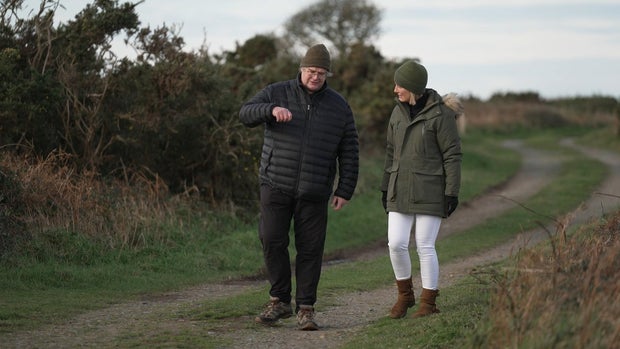
When Germany invaded France in 1940, the British government calculated that the Channel Islands had no strategic value – and gave them up without a fight. Nearly all of the residents of Alderney decided to evacuate before the German troops arrived. On the empty island, the Germans set up two concentration camps – as well as labor camps. They brought in prisoners of war and forced laborers to build giant fortifications that still survive today -- part of Hitler's Atlantic wall to protect against Allied attack. A minority of them were Jewish – others were from Russia, Ukraine, Poland, and Spain.
Holly Williams: I understand this was called the Tunnel of Death?
Marcus Roberts: Yes. It was notorious in the memory of prisoners. On two occasions, they were forced to cram in here in an apparent rehearsal for their own death.
After the war, in 1945, the British military investigated the camps, and put the death toll on Alderney in the low hundreds. Some of those who lost their lives were buried under this plot of land. But Marcus Roberts and others argue that more than 10,000 must have died on the island – based on controversial calculations about the size of the labor force needed to build the fortifications. Roberts told us it's because he's Jewish that he's determined to count all of the dead.
Marcus Roberts: There is the-- the Jewish instinct to, you know, leave no one behind
Holly Williams: You're trying to make sure that all the Jewish dead are counted?
Marcus Roberts: Remembered. If you don't remember a life, it's as if they've never lived at all.
Most academics dispute Roberts' estimate of the death toll, but partly as a result of those disagreements, last year the British government appointed a team of researchers to comb through archives across Europe, and more accurately count the number of prisoners who died on Alderney. Dr. Gilly Carr -- an archaeologist at Cambridge University -- is coordinating the review.
Holly Williams: Why is this just a document search, not a dig?
Gilly Carr: It is likely that some of the people in mass graves were Jewish. And according to Halakha or Jewish law, you cannot disturb the dead. But the second reason is that according to prisoner statements, some people were dumped at sea or thrown off cliffs. What are we going to do? Dig up the entire island? Well, we can't do that.
The researchers are drawing on rich material. The Nazis were meticulous record keepers -- and British archives contain first hand testimonies from survivors.
Holly Williams: Look at this. "We were beaten with everything they could lay their hands on: with sticks, spades, pickaxes."
Gilly Carr: It sounds absolutely ghastly.
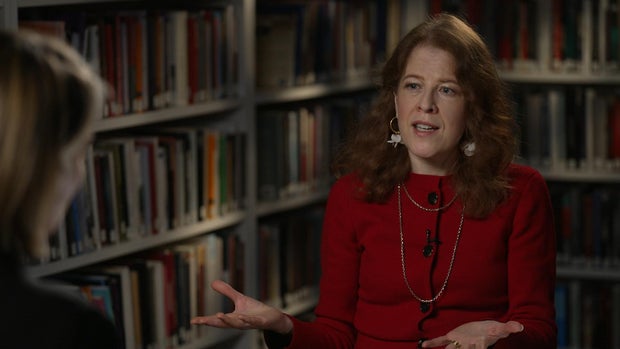
Holly Williams: "On certain days, five to six, up to 10 men died."
Dr. Carr told us there's no evidence that gas chambers were used on Alderney -- but there were summary executions, and the prisoners built the Nazi fortifications on starvation rations.
Holly Williams: Were they taken to Alderney to be worked to death?
Gilly Carr: They were certainly seen as expendable. The aim was to get every ounce of work out of them. And if they died, it didn't matter, and that was kind of perhaps "expected."
Holly Williams: They were disposable human beings.
Gilly Carr: Yes. Yes.
Holly Williams: How did your father end up in Alderney?
At a pub in the Channel Islands, we met Gary Font. His father – Francisco Font – fought on the losing side in the Spanish Civil War, was arrested in France, handed over to the Germans, and sent to a concentration camp on Alderney. Francisco survived, and later married a British woman -- Gary's mother.
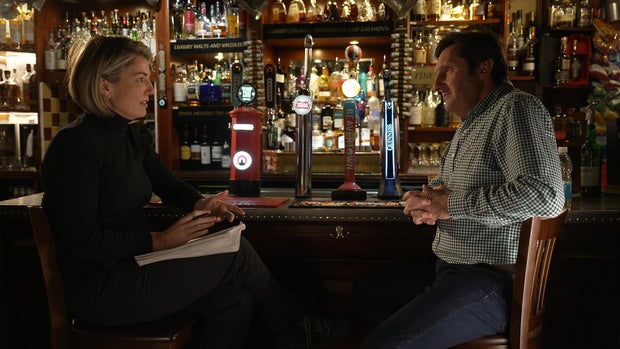
Gary Font: He witnessed-- the execution of a young Soviet boy who decided to leave the working detail and to change his footwear. So he started to pick up these paper bags, and wrap them 'round his feet, and then tie them with string. And a SS guard had seen him do this, and walked up to him and-- and shot him-- point-blank range.
Gary told us his father's experiences left him scarred.
Gary Font: I saw the emotion on his face. Yeah, it's a tough one.
Holly Williams: Do you think that emotion came from-- that he had survived the War in Spain, and survived the camp here?
Gary Font: Yeah, exactly. That was the first time I realized, "Wow, you know, this man has a deep-rooted emotion inside of him that he could never get out."
The British government's effort to get the truth out – by recounting the dead – was commissioned by Lord Pickles – a former cabinet minister and now the U.K.'s envoy for post-Holocaust issues.
Lord Pickles: The figures vary, not by a few hundred, not by a few thousand, by-- by tens of thousands.
Holly Williams: So it was the controversy that prompted you to commission the review?
Lord Pickles: Yes. It seemed to me that the sensible thing was, "Well, okay. Let's do that-- this in the open. Let's do it fully transparent.
He's also asked the researchers to put names to as many of those killed as they can.
Lord Pickles: If you remember them as individuals, then it's another blow against Hitler. Hitler wanted to eradicate the memory of people.

Holly Williams: So this is kind of an ongoing fight against Hitler and his ideas?
Lord Pickles: Hitler's evil hand still continues to affect-- to affect Europe and to affect the world.
But it's taken nearly 80 years for the British government to re-examine what happened on Alderney -- and to make its report public. The official British investigations in 1945 were classified for decades. And unlike the trials of Nazi officials in Nuremberg -- the British authorities failed to prosecute a single German officer who worked on Alderney – even though many of them ended up in British prisoner of war camps.
Holly Williams: I mean just to be clear, these are possible war criminals. The British government has gathered evidence against-- against them. And they are in British custody.
Gilly Carr: Yes, they are at this point, yes.
Holly Williams: A sort of slam-dunk case?
Gilly Carr: You'd have thought.
That's led Marcus Roberts and others to claim that the British government tried to cover-up the extent of the atrocities on Alderney. Dr. Carr told us that could be true -- but one key document from the British War Office investigation that may explain why there were no prosecutions is missing.
Gilly Carr: It could have been shredded-- decades ago as part of, "What do we need these files for anymore?
Holly Williams: But could it also have been shredded for more nefarious purposes?
Gilly Carr: I have no idea. In order for me to say there was a cover-up, I want to see the decisions taken. I want to look through those steps and to make up my own mind.
Holly Williams: Why might the British government have tried to cover up or whitewash what happened on Alderney and-- and maybe more broadly, on the Channel Islands?
Gilly Carr: There are some things that-- that happened that might not-- that the British government might not necessarily have wanted a wider audience to know about.
Those things – once feared too troubling for the broader public – happened on three of the other Channel Islands -- where most residents did not evacuate before the occupation. When the Germans arrived, the locals mostly cooperated – often with little choice. Hitler's portrait was hung outside this cinema on the island of Guernsey. Nazi propaganda showed the British police working for German troops. And British newspapers on the islands printed orders from Berlin.
Holly Williams: This is a British newspaper. And it's got the swastika on top.
Linda Romeril: That's right.
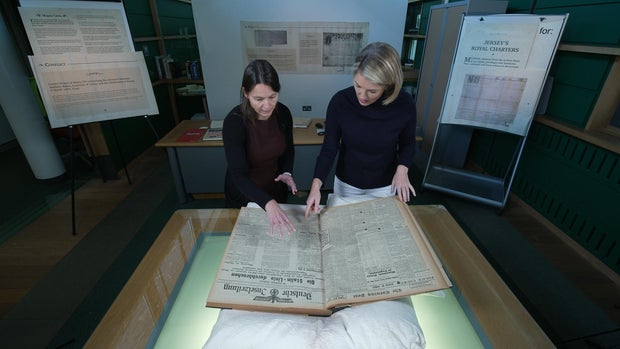
At the official archives on the island of Jersey, Linda Romeril showed us how British officials implemented Nazi policies -- asking Jewish residents to identify themselves, and then confiscating their assets.
Linda Romeril: There was a huge amount of requisitioning of people's houses, people's property during the occupation period.
But some resisted -- risking punishment to paint anti-nazi graffiti, and illegally listening to British news on the radio.
Jenny Lecoat: That's my great aunt Louisa. I suspect that she was probably quite steely.
One member of the resistance was Louisa Gould -- who hid an escaped Russian prisoner in her home for nearly two years. Jenny Lecoat told us when her great aunt Louisa was finally caught, she was sent to Ravensbruck concentration camp in Germany.
Holly Williams: She was killed in a Nazi gas chamber?
Jenny Lecoat: She was gassed to death, yeah.
Holly Williams: After the occupation, did the British government get in touch with your family to talk about what Louisa had done during the occupation, and about her murder by the Nazis?
Jenny Lecoat: The British government, I think, were kind of ashamed. They were horrified it had happened, and they didn't really want to get too involved in what had gone on there.
Holly Williams: Not wanting to talk about the resistance? Or not wanting to talk about the occupation at all?
Jenny Lecoat: Well, it was such a mixed picture. There were people who had resisted the Germans as much as resistance was possible within a tiny, nine-by-five-mile island. And there were also people who'd collaborated. Some people had betrayed their own country. The only possible legislation was treason, which was still a hanging offense. They didn't wanna get into that. That was the confusing, messy, dirty mixed picture of-- of the Channel Islands occupation.
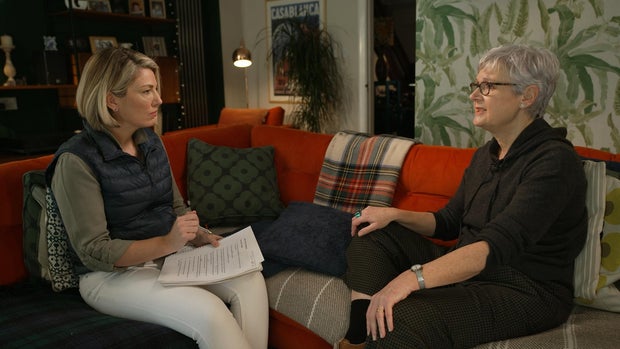
We'll learn more about that messy, dirty history when the British government's review of the death toll at the camps on Alderney is published next month. But it's unlikely to satisfy everyone.
Marcus Roberts: Some kind of-- ap-- apology and, you know, moral recompense would be helpful.
Holly Williams: You-- you want the British government to apologize--
Marcus Roberts: Yeah. I'd like--
Holly Williams: --for not having prosecuted alleged war criminals?
Marcus Roberts: Yeah. So I think it would be appropriate for them to recognize what should have been done, didn't happen.
The horrors carried out on this tiny, remote island are difficult to imagine... the victims were silenced and buried… but now, nearly eight decades later, they're finally being counted.
Produced by Justine Redman and Erin Lyall. Associate producer, Matthew Riley. Broadcast associate, Eliza Costas. Edited by Peter M. Berman.

Holly Williams is a CBS News senior foreign correspondent based in the network's CBS London bureau.
More from CBS News

Cicadas are so loud that South Carolina residents are calling police
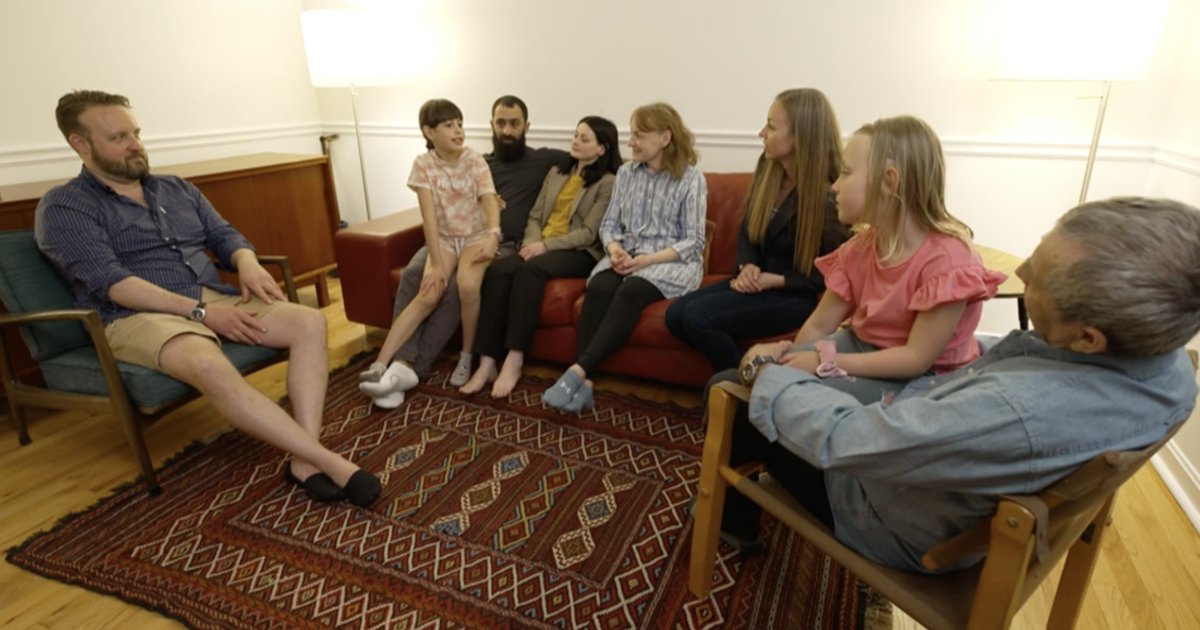
U.S. program has resettled 187,000 Ukrainian refugees with little controversy

Romance scammers turn victims into "money mules"

1.4 tons of cocaine confiscated in one of Sweden's biggest ever seizures

- Berlin In a Day
- Essential Berlin Tour:
- Berlin Wall & Cold War
- Berlin World War Tour
- Sachsenhausen Memorial
- Potsdam Tour
- Berlin Custom Group Tour
- Berlin History and Highlights Tour
- Berlin Wall Tour
- Historic Pubs of Berlin Tour
- Sachsenhausen Memorial Tour
- Third Reich Tour Berlin
- Berlin Blog
- Discover Berlin History & Highlights
- Berlin Wall Bike Tour
- Third Reich World War Sites & History
- Berlin Highlights Brandenburg Gate & Tiergarten
- About / Contact
Sachsenhausen Concentration Camp Tour With Licensed Guide
Sachsenhausen memorial camp tour.

The Berlin Sachsenhausen Tour
The sachsenhausen concentration camp memorial tour visits:, meeting point, sachsnehausen tour, know before you go: sachsenhausen concentration camp tour, sachsenhausem f.a.q., when is the sachsenhausen memorial camps opening hours, sachsenhausen walking, and what to wear, food and drinks at sachsenhausen concentration camp the camp, getting to sachsenhausen from berlin, driving to sachsenhausen from berlin, what to look for at the camp, privacy overview.
Search the Holocaust Encyclopedia
- Animated Map
- Discussion Question
- Media Essay
- Oral History
- Timeline Event
- Clear Selections
- Bahasa Indonesia
- Português do Brasil
Featured Content
Find topics of interest and explore encyclopedia content related to those topics
Find articles, photos, maps, films, and more listed alphabetically
For Teachers
Recommended resources and topics if you have limited time to teach about the Holocaust
Explore the ID Cards to learn more about personal experiences during the Holocaust
Timeline of Events
Explore a timeline of events that occurred before, during, and after the Holocaust.
- Introduction to the Holocaust
- Liberation of Nazi Camps
- Warsaw Ghetto Uprising
- Boycott of Jewish Businesses
- Axis Invasion of Yugoslavia
- Antisemitism
- How Many People did the Nazis Murder?
- The Rwanda Genocide
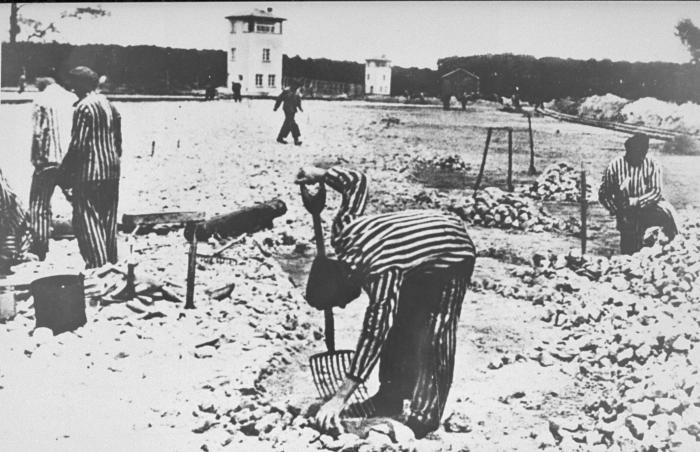
Concentration Camps, 1933–39
During the first six years of the Nazi regime, thousands of Germans were detained or confined extra-legally. The conditions were usually harsh and there was no regard to the legal norms of arrest and imprisonment of a constitutional democracy in terms of arrest and imprisonment.
Nazi officials established the first concentration camp, Dachau, on March 22, 1933, for political prisoners. It was later used as a model for an expanded and centralized concentration camp system managed by the SS.
What distinguishes a concentration camp from a prison (in the modern sense) is that it functions outside of a judicial system. The prisoners are not indicted or convicted of any crime by judicial process.
The major purpose of the earliest concentration camps during the 1930s was to imprison and intimidate the leaders of political, social, and cultural movements that the Nazis perceived to be a threat to the survival of the regime.
- concentration camps
- forced labor
This content is available in the following languages
Concentration camps ( Konzentrationslager ; abbreviated as KL or KZ) were an integral feature of the regime in Nazi Germany between 1933 and 1945.
The term concentration camp refers to a camp in which people are detained or confined, usually under harsh conditions and without regard to legal norms of arrest and imprisonment that are acceptable in a constitutional democracy.
The First Concentration Camps in Germany
German authorities established camps all over Germany on an ad hoc basis to handle the masses of people arrested as alleged subversives. The SS established larger camps in Oranienburg , north of Berlin; Esterwegen, near Hamburg; Dachau , northwest of Munich; and Lichtenburg, in Saxony. In Berlin itself, the Columbia Haus facility held prisoners under investigation by the Gestapo (the German secret state police) until 1936.
Centralization of the Concentration Camp System
After December 1934, the SS became the only agency authorized to establish and manage facilities that were formally called concentration camps. Local civilian authorities did continue to establish and manage forced-labor camps and detention camps throughout Germany. In 1937, only four concentration camps were left: Dachau , near Munich; Sachsenhausen near Berlin; Buchenwald near Weimar; and Lichtenburg near Merseburg in Saxony for female prisoners.
Purposes of the Camp System
Concentration camps are often inaccurately compared to a prison in modern society. But concentration camps, unlike prisons, were independent of any judicial review. Nazi concentration camps served three main purposes:
- To incarcerate people whom the Nazi regime perceived to be a security threat. These people were incarcerated for indefinite amounts of time.
- To eliminate individuals and small, targeted groups of individuals by murder, away from the public and judicial review.
- To exploit forced labor of the prisoner population. This purpose grew out of a labor shortage.
Concentration Camp Administration
Already as commandant of Dachau in 1933, Eicke developed an organization and procedures to administer and guard a concentration camp. He issued regulations for the duties of the perimeter guards and for treatment of the prisoners. The organization, structure, and practice developed at Dachau in 1933–34 became the model for the Nazi concentration camp system as it expanded. Among Eicke's early trainees at Dachau was Rudolf Höss, who later commanded the Auschwitz concentration camp.
Special “political units on alert” ( Politische Bereitschaften ) originally guarded the SS concentration camps. They were renamed “SS Guard Units” ( SS-Wachverbände ) in 1935 and “SS Death's-Head Units” ( SS-Totenkopfverbände ) in April 1936. One SS Death's-Head Unit was assigned to each concentration camp. After 1936, the camp administration, including the commandant, was also a part of the SS Death's-Head Unit.
Although all SS units wore the Death's-Head symbol (skull and crossbones) on their caps, only the SS Death's-Head Units were authorized to wear the Death's Head Symbol on their lapels. The “SS Death's-Head Division” of the Waffen SS was created in 1940. Its officers were recruited from concentration camp service. They also wore the Death's-Head symbol on their lapel.
The SS Death's-Head Unit at each camp was divided into two groups. The first was the camp staff, which covered:
- the commandant and his personal staff
- a Security Police officer and an assistant to maintain and update prisoner records
- the commandant of the so-called protective detention camp ( Schutzhaftlagerführer ) which housed the prisoners, and his staff (including the labor allocation officer, the roll call officer, and the Blockführer, who were responsible for the individual prisoner barracks)
- an administrative staff responsible for the fiscal and supply administration of the camp
- an infirmary run by an SS physician assisted by one or two SS sanitation officers and/or medical orderlies.
The second group constituted the guard detachment ( SS-Wachbataillon ), which prior to 1939 was at battalion strength.
The model established by Eicke in the mid-1930s characterized the concentration camp system until the collapse of the Nazi regime in the spring of 1945. The daily routine at Dachau, the methods of punishment, and the duties of the SS staff and guards became the norm, with some variation, at all German concentration camps.
Authority to Imprison People in Concentration Camps
After 1938, authority to incarcerate persons in a concentration camp formally rested exclusively with the German Security Police (made up of the Gestapo and the Criminal Police ).
The Security Police had held this exclusive authority de facto since 1936. The “legal” instrument of incarceration was either the “protective detention” ( Schutzhaft ) order or the “preventative detention” ( Vorbeugungshaft ) order. The Gestapo could issue a “protective detention” order for persons considered a political danger after 1933. The Criminal Police could issue a “preventative detention” order after December 1937 for persons considered to be habitual and professional criminals, or to be engaging in what the regime defined as “asocial” behavior. Neither order was subject to judicial review, or any review by any German agency outside of the German Security Police. As the concentration camp system expanded, the camps fell within the exclusive authority of the SS. The German judicial administration had no jurisdiction with the growing camp system.
Expansion of the Camp System
Nazi Germany expanded by bloodless conquest into Austria and Czechoslovakia between 1938 and 1939. The numbers of those labeled as political opponents and as “asocials” in German society increased , requiring the establishment of new concentration camps.
By the time the Germans invaded Poland in September 1939, unleashing World War II, there were six concentration camps in the so-called Greater German Reich: Dachau (founded 1933), Sachsenhausen (1936), Buchenwald (1937), Flossenbürg in northeastern Bavaria near the 1937 Czech border (1938), Mauthausen , near Linz, Austria (1938), and Ravensbrück , the women's camp, established in Brandenburg Province, southeast of Berlin (1939), after the dissolution of Lichtenburg.
Forced Labor
Beginning a pattern that became typical after the war began, economic considerations had an increasing impact on the selection of sites for concentration camps after 1937. For instance, Mauthausen and Flossenbürg were located near large stone quarries. Likewise, concentration camp authorities increasingly diverted prisoners from meaningless, backbreaking labor to still backbreaking and dangerous labor in extractive industries, such as stone quarries and coal mines, and construction labor.
Concentration Camps after the Outbreak of World War II
After Nazi Germany unleashed World War II in September 1939, vast new territorial conquests and larger groups of potential prisoners led to the rapid expansion of the concentration camp system to the east. The war did not change the original function of the concentration camps as detention sites for the incarceration of political enemies. The climate of national emergency that the conflict granted to the Nazi leaders, however, permitted the SS to expand the functions of the camps.
The concentration camps increasingly became sites where the SS authorities could kill targeted groups of real or perceived enemies of Nazi Germany. They also came to serve as holding centers for a rapidly growing pool of forced laborers used for SS construction projects, SS-commissioned extractive industrial sites, and, by 1942, the production of armaments, weapons, and related goods for the German war effort.
Despite the need for forced labor, the SS authorities continued to deliberately undernourish and mistreat prisoners incarcerated in the concentration camps. Prisoners were used ruthlessly and without regard to safety at forced labor, resulting in high mortality rates.
Series: Concentration Camps

Concentration Camps, 1939–42
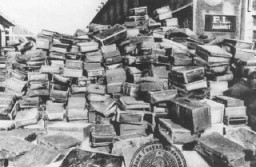
Concentration Camps, 1942–45
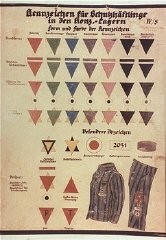
Classification System in Nazi Concentration Camps
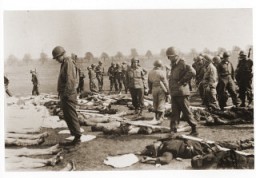
Concentration Camp System: In Depth
Critical thinking questions.
- Concentration camps in these six years were not specifically for Jews. Who was imprisoned there, and why?
- Where were the camps located? To what degree was the German population aware of the camps, their purpose, and the conditions within?
- Did the outside world have any knowledge about these camps? If so, what actions were taken by other countries and their officials? What choices do other countries have in the face of mistreatment of civilians?
Thank you for supporting our work
We would like to thank Crown Family Philanthropies and the Abe and Ida Cooper Foundation for supporting the ongoing work to create content and resources for the Holocaust Encyclopedia. View the list of all donors .
To Duke Alumni homepage
Journey through eastern europe.
View other trips

Date: Sat, September 20, 2025 - Sun, October 5, 2025
Trip Status: Waiting for the brochure
Price: From $6,497 per person including air
Activity Level: Moderate
Region: Europe
Arrangements: Odysseys Unlimited
Leisurely and comprehensive, this 16-day small group tour provides a generous overview of four fascinating Eastern European nations. The journey begins in Poland’s capital, Warsaw, where sightseeing includes the faithfully rebuilt Old Town and moving visits to the Auschwitz and Birkenau concentration camps. Next is historic Krakow with its celebrated medieval Old Town, and touring of the Wieliczka Salt Mine, a virtual underground city carved from salt. Travel through the snowcapped Tatra Mountains to Budapest and get acquainted with the “Paris of the East,” with its splendid architecture and lively café culture. After stops along the scenic Danube Bend, reach beloved Vienna and enjoy a classical music performance and visits to the grand Opera House and majestic Schönbrunn Palace. In elegant Prague, the final destination, touring includes the medieval Old Town, the Castle District, and the historic Jewish Quarter. Experience Germany’s cosmopolitan capital with an optional 4-day/3-night post-tour Berlin extension.
Reservations and Information
To reserve, complete a registration form in the brochure and mail to Duke Travels, Box 90572, Durham, NC 27708, or call (919) 684-2988 to reserve conveniently over the phone and let us know you are mailing your reservation form to hold your space. To learn more about our travel program or any of our upcoming trips, please contact us at [email protected] or 919-684-2988
Duke Leaders
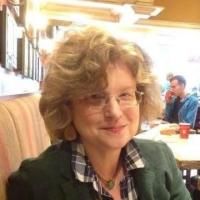
Dr. Beth Holmgren
Professor of Polish and Russian Studies
Mode of Travel


COMMENTS
The Grand Tour Visits a German Concentration Camp. Next stop: Jeremy posted a photo to his Instagram account of Stalag Luft 3, a German concentration camp in the town of town of Sagan, Lower Silesia. This continues the WWII theme and should act as a sobering moment in the episode. Around this time the team also visited Krakow.
In their latest adventure-filled episode, "The Grand Tour: Eurocrash," renowned presenters Richard Hammond, Jeremy Clarkson, and James May embark on an exhilarating journey across the captivating landscapes of Europe. Starting their epic road trip in the historic city of Gdańsk, Poland, the trio sets off on a high-octane adventure. From the picturesque streets of Długi […]
A tour lasts approximately 3.5 hours and it starts at Auschwitz I. The price includes a tour of the former Auschwitz I and Auschwitz II-Birkenau camps with a guide-educator, rental of a headset. The Museum provides transfer between both sites of the former camp. The shuttle bus is intended for individual visitors in guided tours.
Auschwitz 1,2 and 3. Anne Frank's House. The Holocaust Memorial Berlin. Schindler's Factory. Yad Vashem. Warsaw Ghetto. The Holocaust is one of the most unfathomable events in human history. Many say that it can never truly be appreciated or understood until you see some of these sites for yourself. It is also important to further educate ...
Ohrdruf. The Ohrdruf camp was a subcamp of the Buchenwald concentration camp, and the first Nazi camp liberated by US troops. The year 2020 marked the 75th anniversary of the liberation of concentration camps by US forces and the end of Nazi tyranny in Europe. The Ohrdruf camp was created in November 1944 near the town of Gotha, Germany.
Camp System: Maps German authorities under National Socialism established a variety of detention facilities to confine those whom they defined as political, ideological, or racial opponents of the regime.In time their extensive camp system came to include concentration camps, where persons were incarcerated without observation of the standard norms applying to arrest and custody; labor camps ...
Auschwitz is the German name for the Polish city Oświęcim. Oświęcim is located in Poland, approximately 40 miles (about 64 km) west of Kraków. Germany annexed this area of Poland in 1939. The Auschwitz concentration camp was located on the outskirts of Oświęcim in German-occupied Poland.
The Grand Tour Visits a German Concentration Camp. Next stop: Jeremy posted a photo to his Instagram account of Stalag Luft 3, a German concentration camp in the town of Sagan, Lower Silesia. This continues the WWII theme and should act as a sobering moment in the episode.
Auschwitz, the largest and arguably the most notorious of all the Nazi death camps, opened in the spring of 1940. Its first commandant was Rudolf Höss (1900-47), who previously had helped run the ...
Each includes tours of Auschwitz I and Auschwitz II-Birkenau. • General tours (2,5 h) • General tours (3,5 h) • Guided tours for individual visitors (3,5 h) • One-day study tours (6 h) • Two-day study tours (2x3 h) • Online tour (2 h) Because of a large number of visitors guides should be reserved at least two months before a ...
Tour Introduction. In this 8-day tour to Poland, we visit the sites of the former ghettos in Warsaw, Lublin and Krakow alongside four of the concentration and death camps - Treblinka, Majdanek, Belzec and Auschwitz-Birkenau - that played such a significant role in this genocide. We look at the struggle of both the Jews and the Poles against ...
Main track of Auschwitz-Birkenau. Permanent exhibit at Auschwitz-Birkenau State Museum.. Holocaust tourism is tourism to destinations connected with the extermination of Jews during the Holocaust in World War II, including visits to sites of Jewish martyrology such as former Nazi death camps and concentration camps turned into state museums. It belongs to a category of the so-called 'roots ...
Visitors can choose the following types of visiting: general visit. one-day study visit. two-day study visit. General visit (time of visit: approx. 3.5 h): Visit at the permanent exhibition and objects in the area of mother camp Auschwitz I. Visit at the most important post-camp objects in Auschwitz II - Birkenau: prisoners' barracks ...
In concentration camps across Europe, 6 million Jewish people were killed - around 78% of all Jews in occupied Europe. ... Visitors can tour the grounds and the remains of the camp and audio guides are available as are guided tours. There are several exhibitions detailing the history of the camp as well as a documentary shown at various times.
The First Concentration Camp. The major purpose of the earliest concentration camps during the 1930s was to incarcerate and intimidate the leaders of political, social, and cultural movements that the Nazis perceived to be a threat to the survival of the regime. The first Nazi concentration camp was Dachau, established in March 1933, near Munich.
9. Dachau Concentration Camp. If you're in Nuremberg for more than a day, you can day trip to Dachau Concentration Camp. It's a 1:40 drive from Nuremberg. Be sure to pick up an audio guide to orient yourself. It's a vast space. Dachau played a significant role in having Hilter's history in Germany.
Dachau Concentration Camp began operation on March 22, 1933 in the town of Dachau, about 10 miles northwest of Munich, Germany (the birthplace of the Nazi party ). It began as a camp strictly for political prisoners—social democrats, communists, other Nazi political opponents and the like—and held 4,800 prisoners when it opened.
This is a version of a previously released video at the Dachau concentration camp. That version contained a photo of the crematorium at Dachau that was taken...
We offer visitors several options for guided tours. Each includes tours of Auschwitz I and Auschwitz II-Birkenau. • General tours (3,5 h) • Guided tours for individual visitors (3,5 h) • One or two-day study tours (6 h or 3+3 h) • General tours - shorter version before closing hours (2,5 h) • Online tour (2 h) Because of a large ...
German troops set up two concentration camps, as well as labor camps, on the island of Alderney. While the British military investigated the camps after the war ended in 1945, the number of deaths ...
Investigating the horrors of a Nazi concentration camp built on British soil 13:11. The names Auschwitz, Bergen-Belsen and Buchenwald are infamous as the scene of atrocities -- concentration camps ...
Liberation. In 1944-1945, the Allied armies liberated the concentration camps. Tragically, deaths in the camps continued for several weeks after liberation. Some prisoners had already become too weak to survive. According to SS reports, there were more than 700,000 prisoners left in the camps in January 1945.
The Sachsenhausen tour starts in Berlin City Center, where you will meet with your guide. After which, we take a short train ride out to the town of Oranienburg the site of the Sachsenhausen Camp Memorial. On the way there we will learn how Hitler achieved the dictatorship and how the concentration camps in their earliest incarnation were a key ...
1. Nazi officials established the first concentration camp, Dachau, on March 22, 1933, for political prisoners. It was later used as a model for an expanded and centralized concentration camp system managed by the SS. 2. What distinguishes a concentration camp from a prison (in the modern sense) is that it functions outside of a judicial system.
Leisurely and comprehensive, this 16-day small group tour provides a generous overview of four fascinating Eastern European nations. The journey begins in Poland's capital, Warsaw, where sightseeing includes the faithfully rebuilt Old Town and moving visits to the Auschwitz and Birkenau concentration camps. Next is historic Krakow with its celebrated medieval Old Town, and touring of the ...